Analysis of South Africa and China for Expansion of AUSMED
VerifiedAdded on 2022/12/29
|20
|4287
|76
AI Summary
This paper focuses on the company AUSMED; an Australia based pharmaceutical company that has been facing issues because of their stagnation in terms of growth in the market. The company has been a successful company however this issue has made them take a decision of expanding in the foreign market in order to generate sales and improve their situation. The company has been considering South Africa and China for expansion to overcome this issue. This paper will assess the external environment of both the countries by conducting PESTEL analysis which will give an insight about the current market situation of the countries and which country will be more favorable for expansion. From the conducted analysis it has been seen that China is more favorable and entering the market with a joint venture will be feasible for AUSMED to establish them successfully and strive in the Chinese market and also help them in generating profits.
Contribute Materials
Your contribution can guide someone’s learning journey. Share your
documents today.
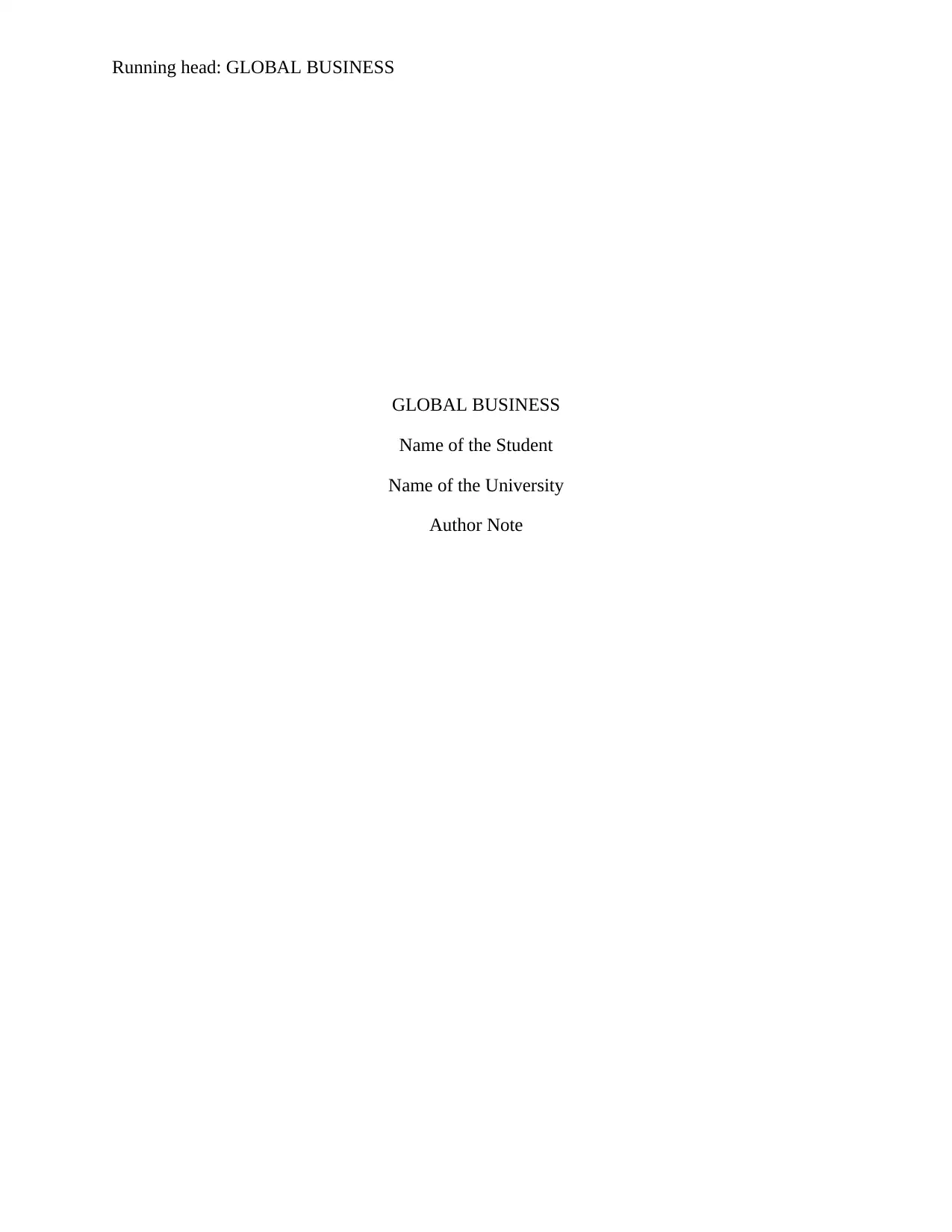
Running head: GLOBAL BUSINESS
GLOBAL BUSINESS
Name of the Student
Name of the University
Author Note
GLOBAL BUSINESS
Name of the Student
Name of the University
Author Note
Secure Best Marks with AI Grader
Need help grading? Try our AI Grader for instant feedback on your assignments.
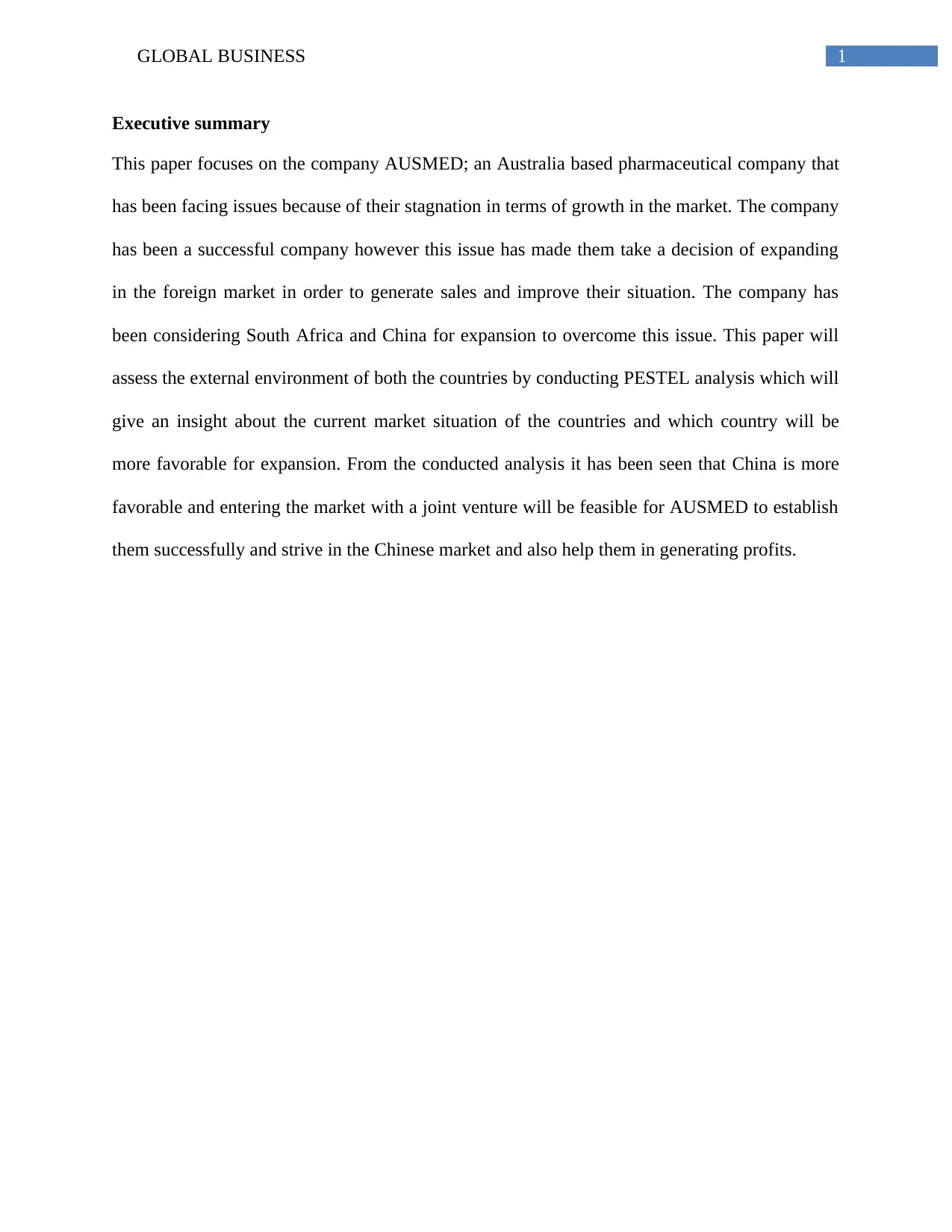
1GLOBAL BUSINESS
Executive summary
This paper focuses on the company AUSMED; an Australia based pharmaceutical company that
has been facing issues because of their stagnation in terms of growth in the market. The company
has been a successful company however this issue has made them take a decision of expanding
in the foreign market in order to generate sales and improve their situation. The company has
been considering South Africa and China for expansion to overcome this issue. This paper will
assess the external environment of both the countries by conducting PESTEL analysis which will
give an insight about the current market situation of the countries and which country will be
more favorable for expansion. From the conducted analysis it has been seen that China is more
favorable and entering the market with a joint venture will be feasible for AUSMED to establish
them successfully and strive in the Chinese market and also help them in generating profits.
Executive summary
This paper focuses on the company AUSMED; an Australia based pharmaceutical company that
has been facing issues because of their stagnation in terms of growth in the market. The company
has been a successful company however this issue has made them take a decision of expanding
in the foreign market in order to generate sales and improve their situation. The company has
been considering South Africa and China for expansion to overcome this issue. This paper will
assess the external environment of both the countries by conducting PESTEL analysis which will
give an insight about the current market situation of the countries and which country will be
more favorable for expansion. From the conducted analysis it has been seen that China is more
favorable and entering the market with a joint venture will be feasible for AUSMED to establish
them successfully and strive in the Chinese market and also help them in generating profits.
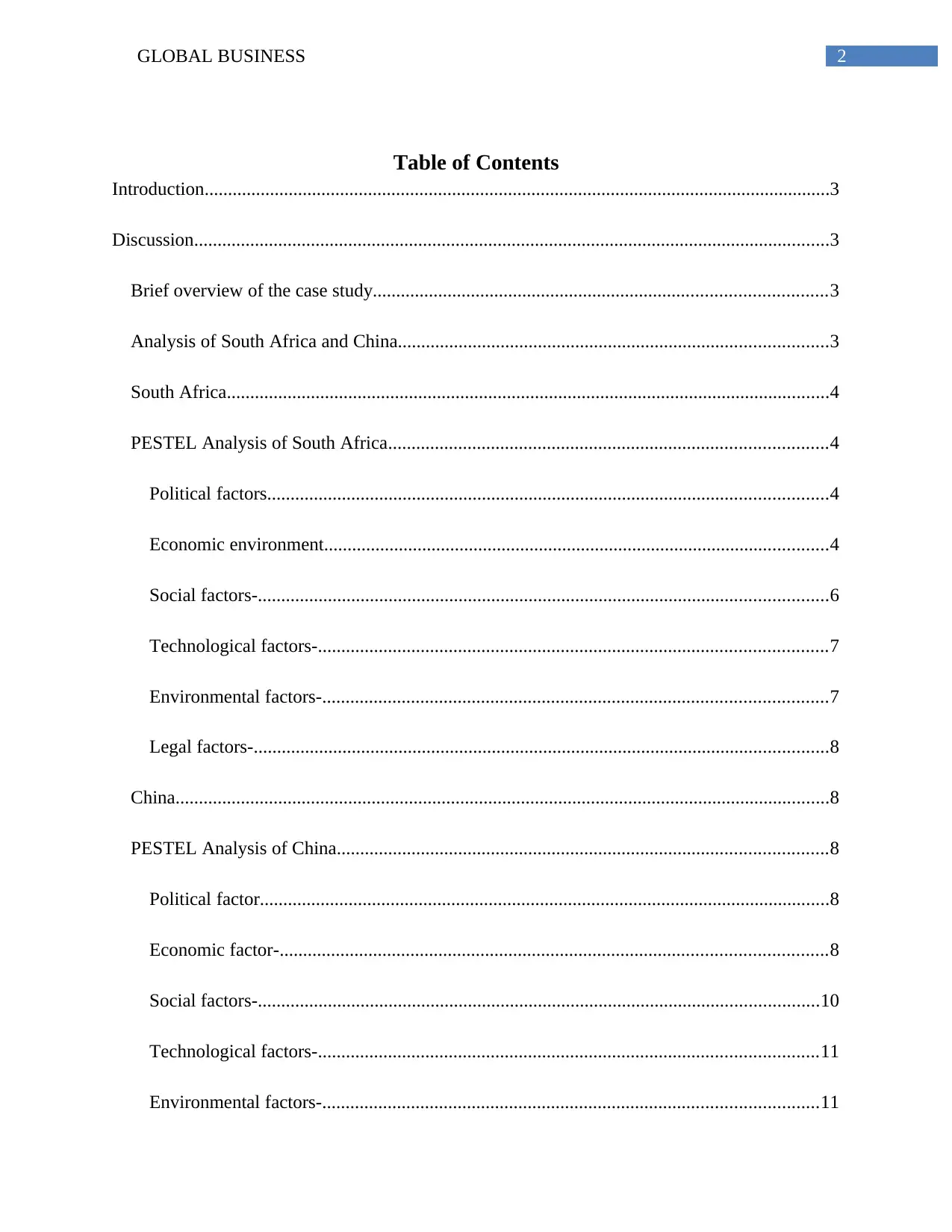
2GLOBAL BUSINESS
Table of Contents
Introduction......................................................................................................................................3
Discussion........................................................................................................................................3
Brief overview of the case study.................................................................................................3
Analysis of South Africa and China............................................................................................3
South Africa.................................................................................................................................4
PESTEL Analysis of South Africa..............................................................................................4
Political factors........................................................................................................................4
Economic environment............................................................................................................4
Social factors-..........................................................................................................................6
Technological factors-.............................................................................................................7
Environmental factors-............................................................................................................7
Legal factors-...........................................................................................................................8
China............................................................................................................................................8
PESTEL Analysis of China.........................................................................................................8
Political factor..........................................................................................................................8
Economic factor-.....................................................................................................................8
Social factors-........................................................................................................................10
Technological factors-...........................................................................................................11
Environmental factors-..........................................................................................................11
Table of Contents
Introduction......................................................................................................................................3
Discussion........................................................................................................................................3
Brief overview of the case study.................................................................................................3
Analysis of South Africa and China............................................................................................3
South Africa.................................................................................................................................4
PESTEL Analysis of South Africa..............................................................................................4
Political factors........................................................................................................................4
Economic environment............................................................................................................4
Social factors-..........................................................................................................................6
Technological factors-.............................................................................................................7
Environmental factors-............................................................................................................7
Legal factors-...........................................................................................................................8
China............................................................................................................................................8
PESTEL Analysis of China.........................................................................................................8
Political factor..........................................................................................................................8
Economic factor-.....................................................................................................................8
Social factors-........................................................................................................................10
Technological factors-...........................................................................................................11
Environmental factors-..........................................................................................................11
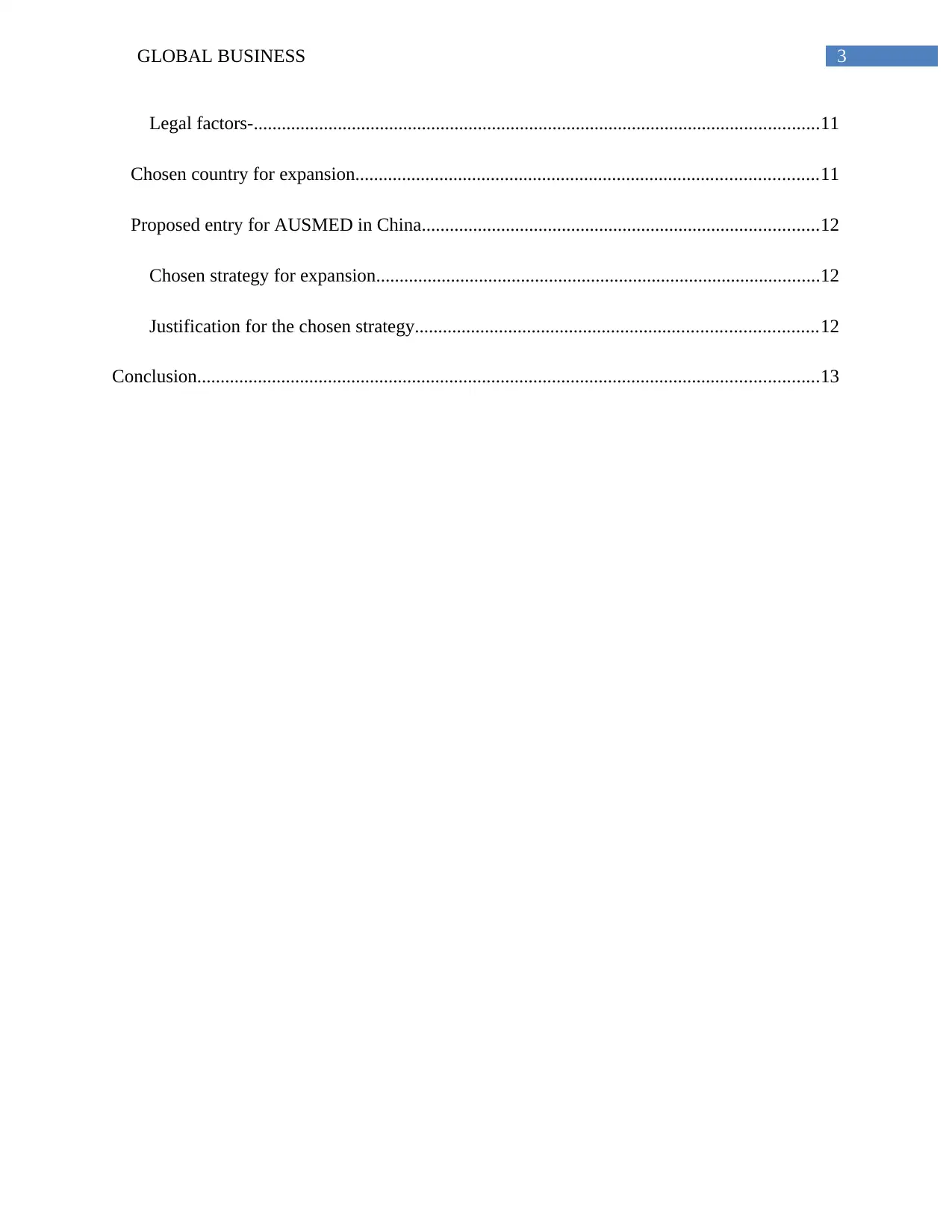
3GLOBAL BUSINESS
Legal factors-.........................................................................................................................11
Chosen country for expansion...................................................................................................11
Proposed entry for AUSMED in China.....................................................................................12
Chosen strategy for expansion...............................................................................................12
Justification for the chosen strategy......................................................................................12
Conclusion.....................................................................................................................................13
Legal factors-.........................................................................................................................11
Chosen country for expansion...................................................................................................11
Proposed entry for AUSMED in China.....................................................................................12
Chosen strategy for expansion...............................................................................................12
Justification for the chosen strategy......................................................................................12
Conclusion.....................................................................................................................................13
Secure Best Marks with AI Grader
Need help grading? Try our AI Grader for instant feedback on your assignments.
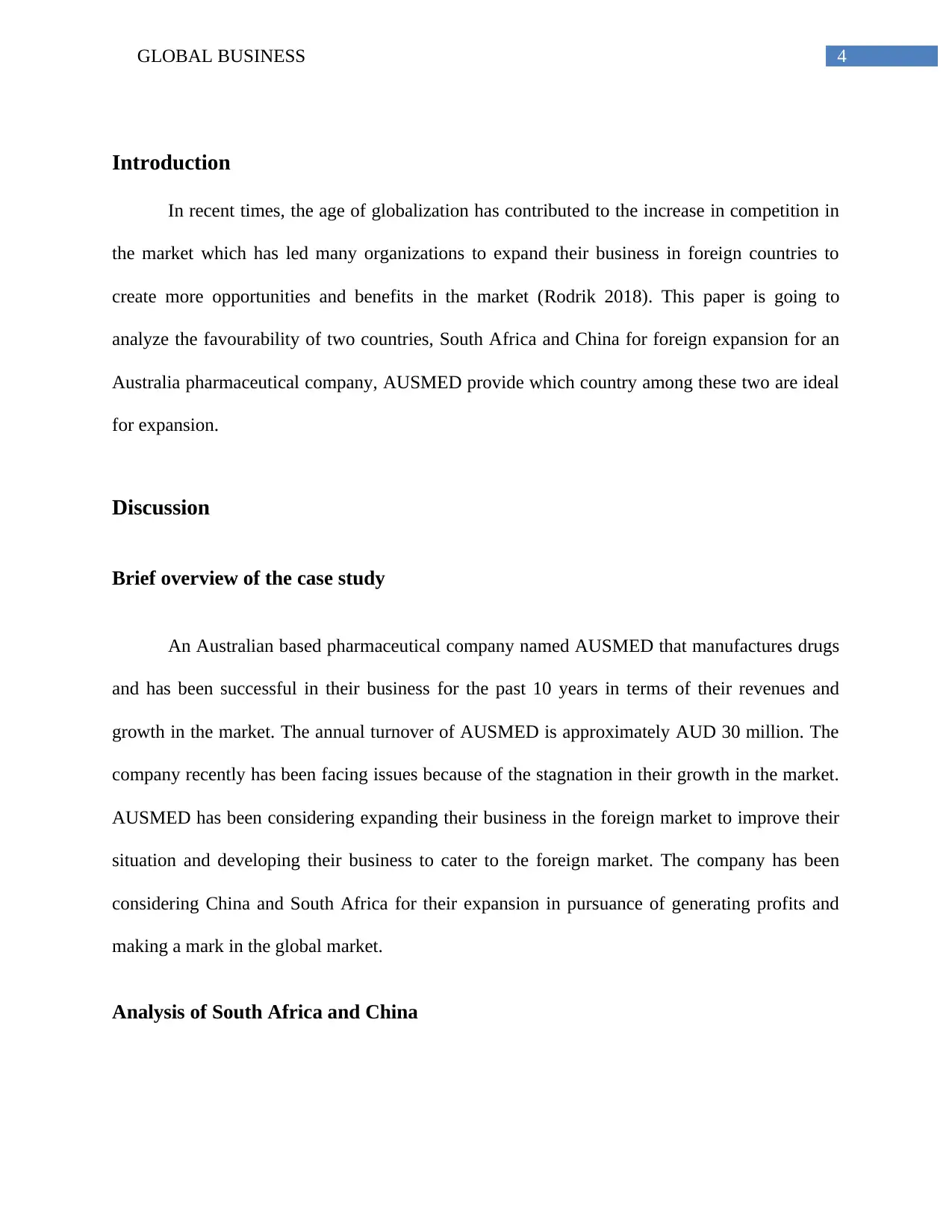
4GLOBAL BUSINESS
Introduction
In recent times, the age of globalization has contributed to the increase in competition in
the market which has led many organizations to expand their business in foreign countries to
create more opportunities and benefits in the market (Rodrik 2018). This paper is going to
analyze the favourability of two countries, South Africa and China for foreign expansion for an
Australia pharmaceutical company, AUSMED provide which country among these two are ideal
for expansion.
Discussion
Brief overview of the case study
An Australian based pharmaceutical company named AUSMED that manufactures drugs
and has been successful in their business for the past 10 years in terms of their revenues and
growth in the market. The annual turnover of AUSMED is approximately AUD 30 million. The
company recently has been facing issues because of the stagnation in their growth in the market.
AUSMED has been considering expanding their business in the foreign market to improve their
situation and developing their business to cater to the foreign market. The company has been
considering China and South Africa for their expansion in pursuance of generating profits and
making a mark in the global market.
Analysis of South Africa and China
Introduction
In recent times, the age of globalization has contributed to the increase in competition in
the market which has led many organizations to expand their business in foreign countries to
create more opportunities and benefits in the market (Rodrik 2018). This paper is going to
analyze the favourability of two countries, South Africa and China for foreign expansion for an
Australia pharmaceutical company, AUSMED provide which country among these two are ideal
for expansion.
Discussion
Brief overview of the case study
An Australian based pharmaceutical company named AUSMED that manufactures drugs
and has been successful in their business for the past 10 years in terms of their revenues and
growth in the market. The annual turnover of AUSMED is approximately AUD 30 million. The
company recently has been facing issues because of the stagnation in their growth in the market.
AUSMED has been considering expanding their business in the foreign market to improve their
situation and developing their business to cater to the foreign market. The company has been
considering China and South Africa for their expansion in pursuance of generating profits and
making a mark in the global market.
Analysis of South Africa and China
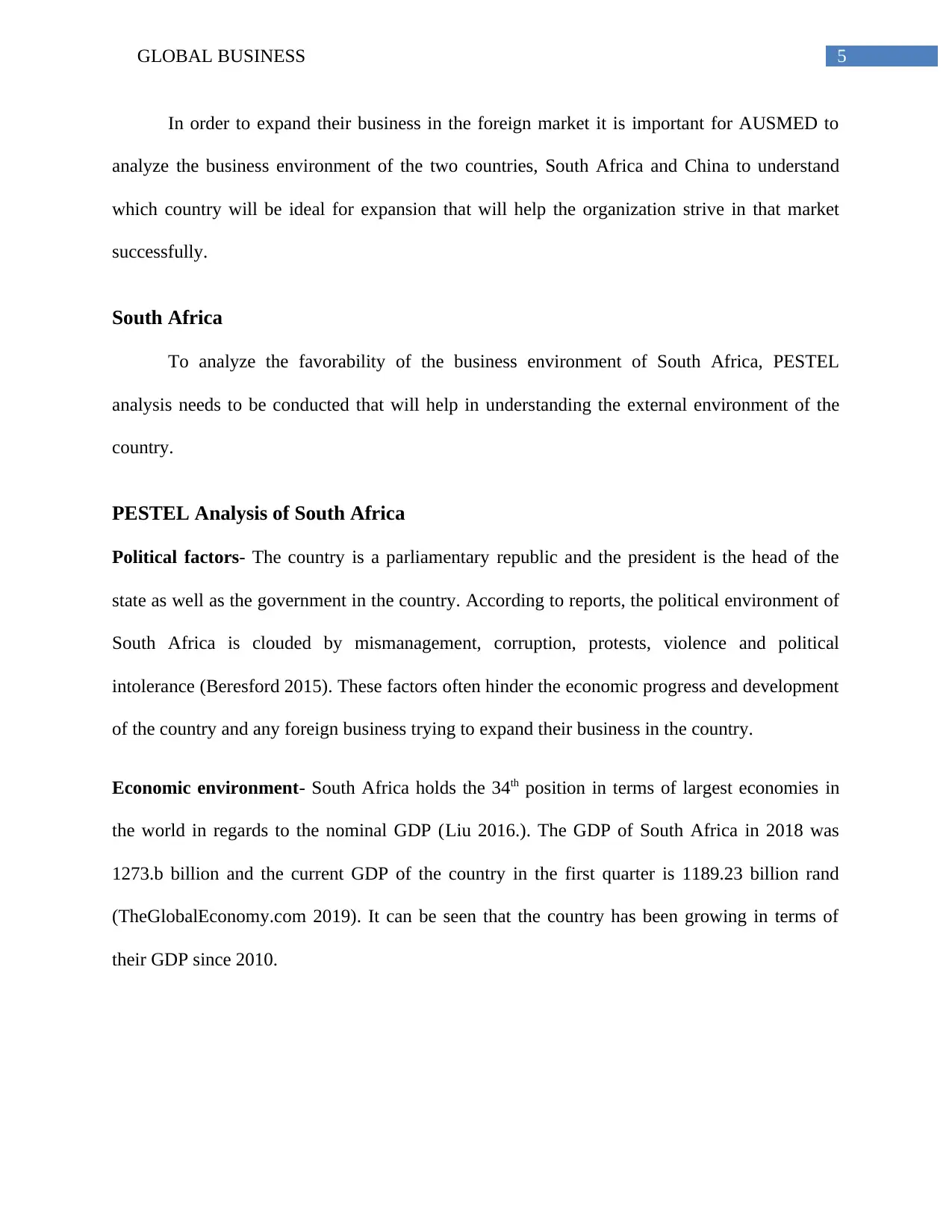
5GLOBAL BUSINESS
In order to expand their business in the foreign market it is important for AUSMED to
analyze the business environment of the two countries, South Africa and China to understand
which country will be ideal for expansion that will help the organization strive in that market
successfully.
South Africa
To analyze the favorability of the business environment of South Africa, PESTEL
analysis needs to be conducted that will help in understanding the external environment of the
country.
PESTEL Analysis of South Africa
Political factors- The country is a parliamentary republic and the president is the head of the
state as well as the government in the country. According to reports, the political environment of
South Africa is clouded by mismanagement, corruption, protests, violence and political
intolerance (Beresford 2015). These factors often hinder the economic progress and development
of the country and any foreign business trying to expand their business in the country.
Economic environment- South Africa holds the 34th position in terms of largest economies in
the world in regards to the nominal GDP (Liu 2016.). The GDP of South Africa in 2018 was
1273.b billion and the current GDP of the country in the first quarter is 1189.23 billion rand
(TheGlobalEconomy.com 2019). It can be seen that the country has been growing in terms of
their GDP since 2010.
In order to expand their business in the foreign market it is important for AUSMED to
analyze the business environment of the two countries, South Africa and China to understand
which country will be ideal for expansion that will help the organization strive in that market
successfully.
South Africa
To analyze the favorability of the business environment of South Africa, PESTEL
analysis needs to be conducted that will help in understanding the external environment of the
country.
PESTEL Analysis of South Africa
Political factors- The country is a parliamentary republic and the president is the head of the
state as well as the government in the country. According to reports, the political environment of
South Africa is clouded by mismanagement, corruption, protests, violence and political
intolerance (Beresford 2015). These factors often hinder the economic progress and development
of the country and any foreign business trying to expand their business in the country.
Economic environment- South Africa holds the 34th position in terms of largest economies in
the world in regards to the nominal GDP (Liu 2016.). The GDP of South Africa in 2018 was
1273.b billion and the current GDP of the country in the first quarter is 1189.23 billion rand
(TheGlobalEconomy.com 2019). It can be seen that the country has been growing in terms of
their GDP since 2010.
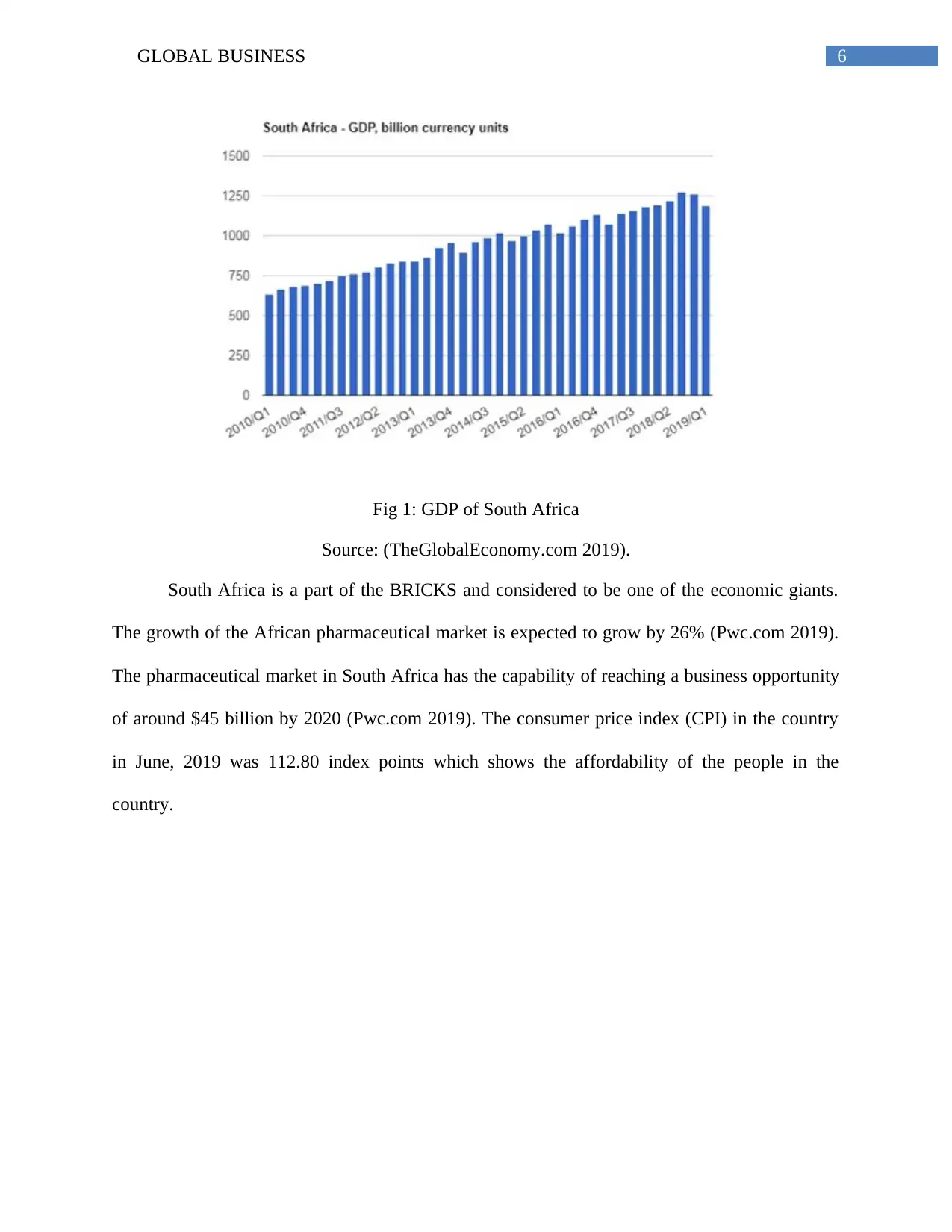
6GLOBAL BUSINESS
Fig 1: GDP of South Africa
Source: (TheGlobalEconomy.com 2019).
South Africa is a part of the BRICKS and considered to be one of the economic giants.
The growth of the African pharmaceutical market is expected to grow by 26% (Pwc.com 2019).
The pharmaceutical market in South Africa has the capability of reaching a business opportunity
of around $45 billion by 2020 (Pwc.com 2019). The consumer price index (CPI) in the country
in June, 2019 was 112.80 index points which shows the affordability of the people in the
country.
Fig 1: GDP of South Africa
Source: (TheGlobalEconomy.com 2019).
South Africa is a part of the BRICKS and considered to be one of the economic giants.
The growth of the African pharmaceutical market is expected to grow by 26% (Pwc.com 2019).
The pharmaceutical market in South Africa has the capability of reaching a business opportunity
of around $45 billion by 2020 (Pwc.com 2019). The consumer price index (CPI) in the country
in June, 2019 was 112.80 index points which shows the affordability of the people in the
country.
Paraphrase This Document
Need a fresh take? Get an instant paraphrase of this document with our AI Paraphraser
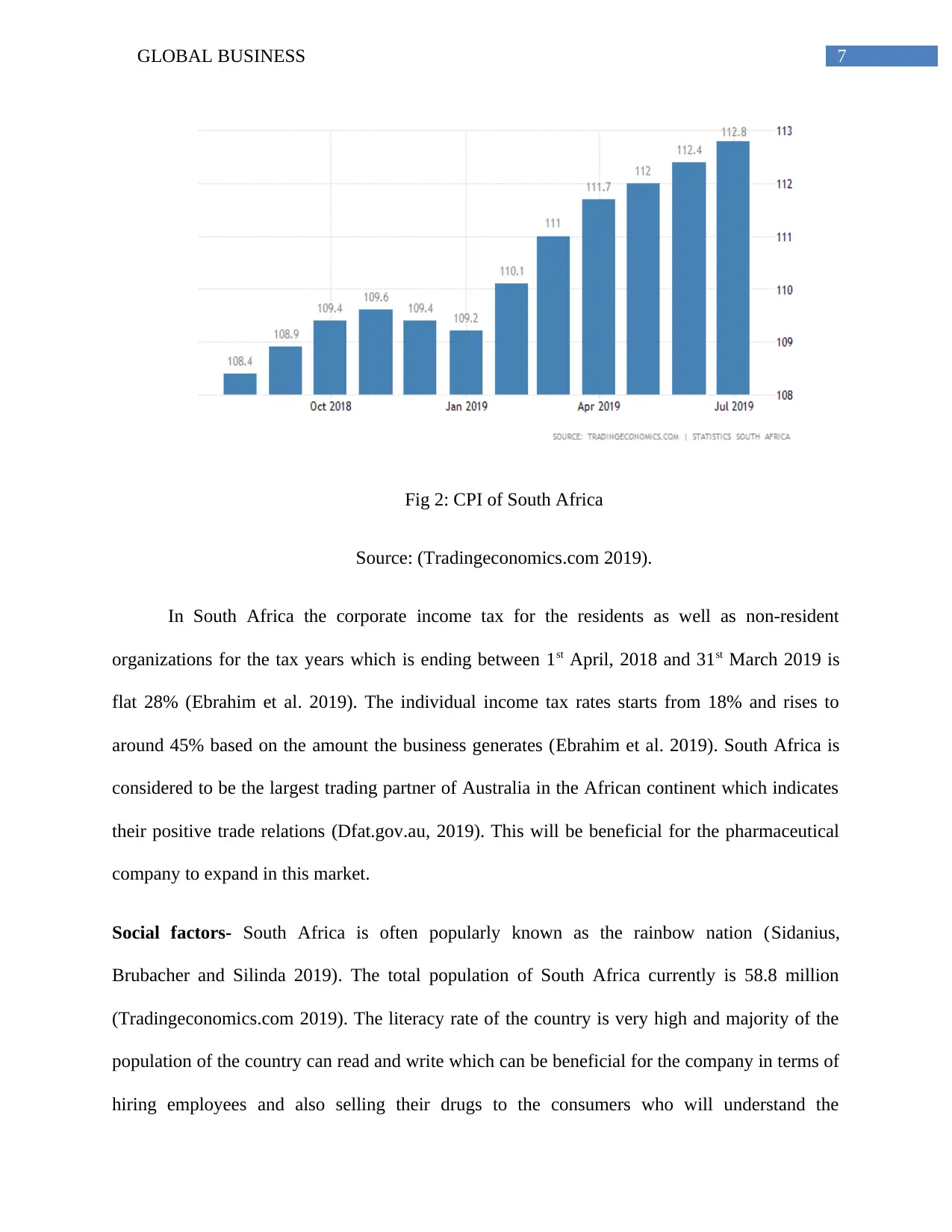
7GLOBAL BUSINESS
Fig 2: CPI of South Africa
Source: (Tradingeconomics.com 2019).
In South Africa the corporate income tax for the residents as well as non-resident
organizations for the tax years which is ending between 1st April, 2018 and 31st March 2019 is
flat 28% (Ebrahim et al. 2019). The individual income tax rates starts from 18% and rises to
around 45% based on the amount the business generates (Ebrahim et al. 2019). South Africa is
considered to be the largest trading partner of Australia in the African continent which indicates
their positive trade relations (Dfat.gov.au, 2019). This will be beneficial for the pharmaceutical
company to expand in this market.
Social factors- South Africa is often popularly known as the rainbow nation (Sidanius,
Brubacher and Silinda 2019). The total population of South Africa currently is 58.8 million
(Tradingeconomics.com 2019). The literacy rate of the country is very high and majority of the
population of the country can read and write which can be beneficial for the company in terms of
hiring employees and also selling their drugs to the consumers who will understand the
Fig 2: CPI of South Africa
Source: (Tradingeconomics.com 2019).
In South Africa the corporate income tax for the residents as well as non-resident
organizations for the tax years which is ending between 1st April, 2018 and 31st March 2019 is
flat 28% (Ebrahim et al. 2019). The individual income tax rates starts from 18% and rises to
around 45% based on the amount the business generates (Ebrahim et al. 2019). South Africa is
considered to be the largest trading partner of Australia in the African continent which indicates
their positive trade relations (Dfat.gov.au, 2019). This will be beneficial for the pharmaceutical
company to expand in this market.
Social factors- South Africa is often popularly known as the rainbow nation (Sidanius,
Brubacher and Silinda 2019). The total population of South Africa currently is 58.8 million
(Tradingeconomics.com 2019). The literacy rate of the country is very high and majority of the
population of the country can read and write which can be beneficial for the company in terms of
hiring employees and also selling their drugs to the consumers who will understand the
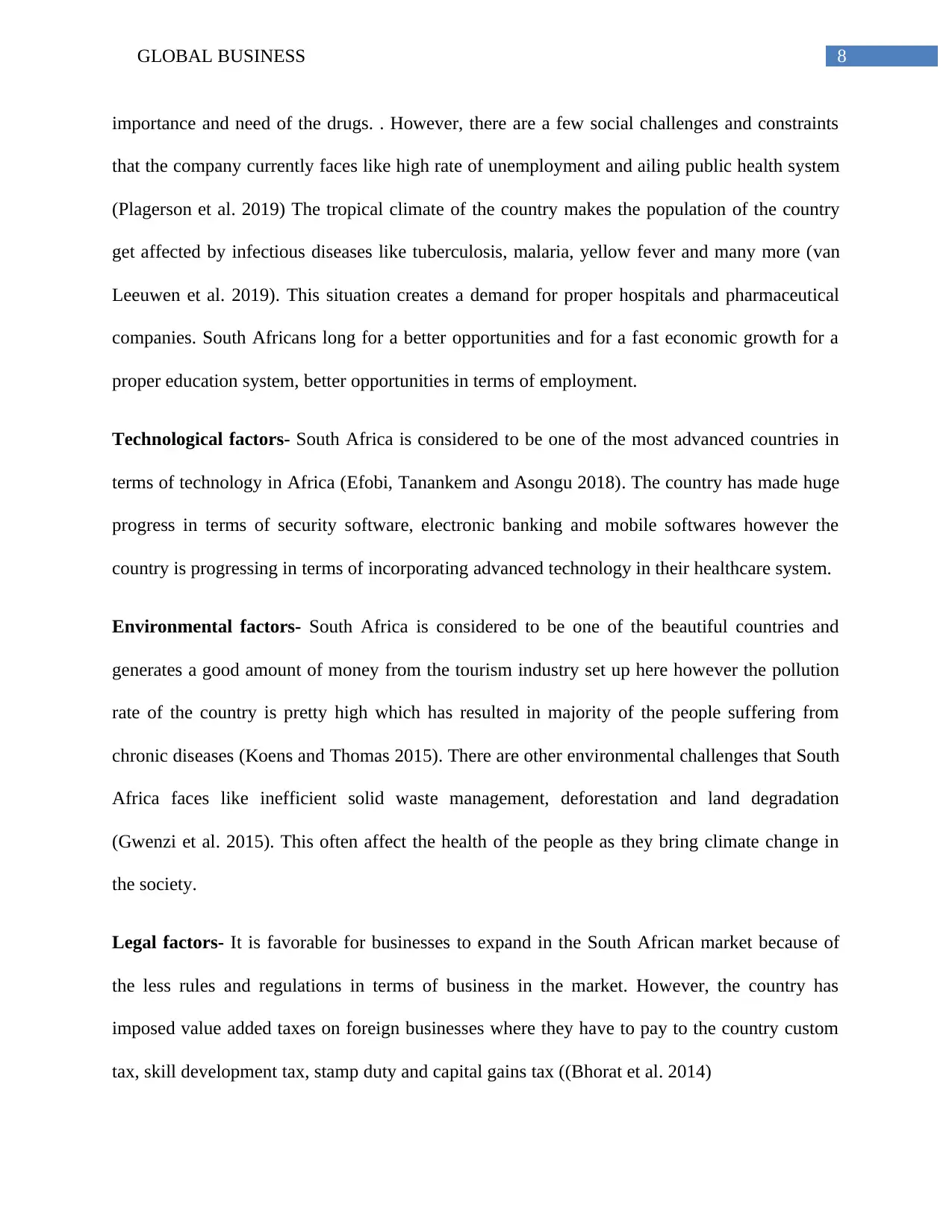
8GLOBAL BUSINESS
importance and need of the drugs. . However, there are a few social challenges and constraints
that the company currently faces like high rate of unemployment and ailing public health system
(Plagerson et al. 2019) The tropical climate of the country makes the population of the country
get affected by infectious diseases like tuberculosis, malaria, yellow fever and many more (van
Leeuwen et al. 2019). This situation creates a demand for proper hospitals and pharmaceutical
companies. South Africans long for a better opportunities and for a fast economic growth for a
proper education system, better opportunities in terms of employment.
Technological factors- South Africa is considered to be one of the most advanced countries in
terms of technology in Africa (Efobi, Tanankem and Asongu 2018). The country has made huge
progress in terms of security software, electronic banking and mobile softwares however the
country is progressing in terms of incorporating advanced technology in their healthcare system.
Environmental factors- South Africa is considered to be one of the beautiful countries and
generates a good amount of money from the tourism industry set up here however the pollution
rate of the country is pretty high which has resulted in majority of the people suffering from
chronic diseases (Koens and Thomas 2015). There are other environmental challenges that South
Africa faces like inefficient solid waste management, deforestation and land degradation
(Gwenzi et al. 2015). This often affect the health of the people as they bring climate change in
the society.
Legal factors- It is favorable for businesses to expand in the South African market because of
the less rules and regulations in terms of business in the market. However, the country has
imposed value added taxes on foreign businesses where they have to pay to the country custom
tax, skill development tax, stamp duty and capital gains tax ((Bhorat et al. 2014)
importance and need of the drugs. . However, there are a few social challenges and constraints
that the company currently faces like high rate of unemployment and ailing public health system
(Plagerson et al. 2019) The tropical climate of the country makes the population of the country
get affected by infectious diseases like tuberculosis, malaria, yellow fever and many more (van
Leeuwen et al. 2019). This situation creates a demand for proper hospitals and pharmaceutical
companies. South Africans long for a better opportunities and for a fast economic growth for a
proper education system, better opportunities in terms of employment.
Technological factors- South Africa is considered to be one of the most advanced countries in
terms of technology in Africa (Efobi, Tanankem and Asongu 2018). The country has made huge
progress in terms of security software, electronic banking and mobile softwares however the
country is progressing in terms of incorporating advanced technology in their healthcare system.
Environmental factors- South Africa is considered to be one of the beautiful countries and
generates a good amount of money from the tourism industry set up here however the pollution
rate of the country is pretty high which has resulted in majority of the people suffering from
chronic diseases (Koens and Thomas 2015). There are other environmental challenges that South
Africa faces like inefficient solid waste management, deforestation and land degradation
(Gwenzi et al. 2015). This often affect the health of the people as they bring climate change in
the society.
Legal factors- It is favorable for businesses to expand in the South African market because of
the less rules and regulations in terms of business in the market. However, the country has
imposed value added taxes on foreign businesses where they have to pay to the country custom
tax, skill development tax, stamp duty and capital gains tax ((Bhorat et al. 2014)
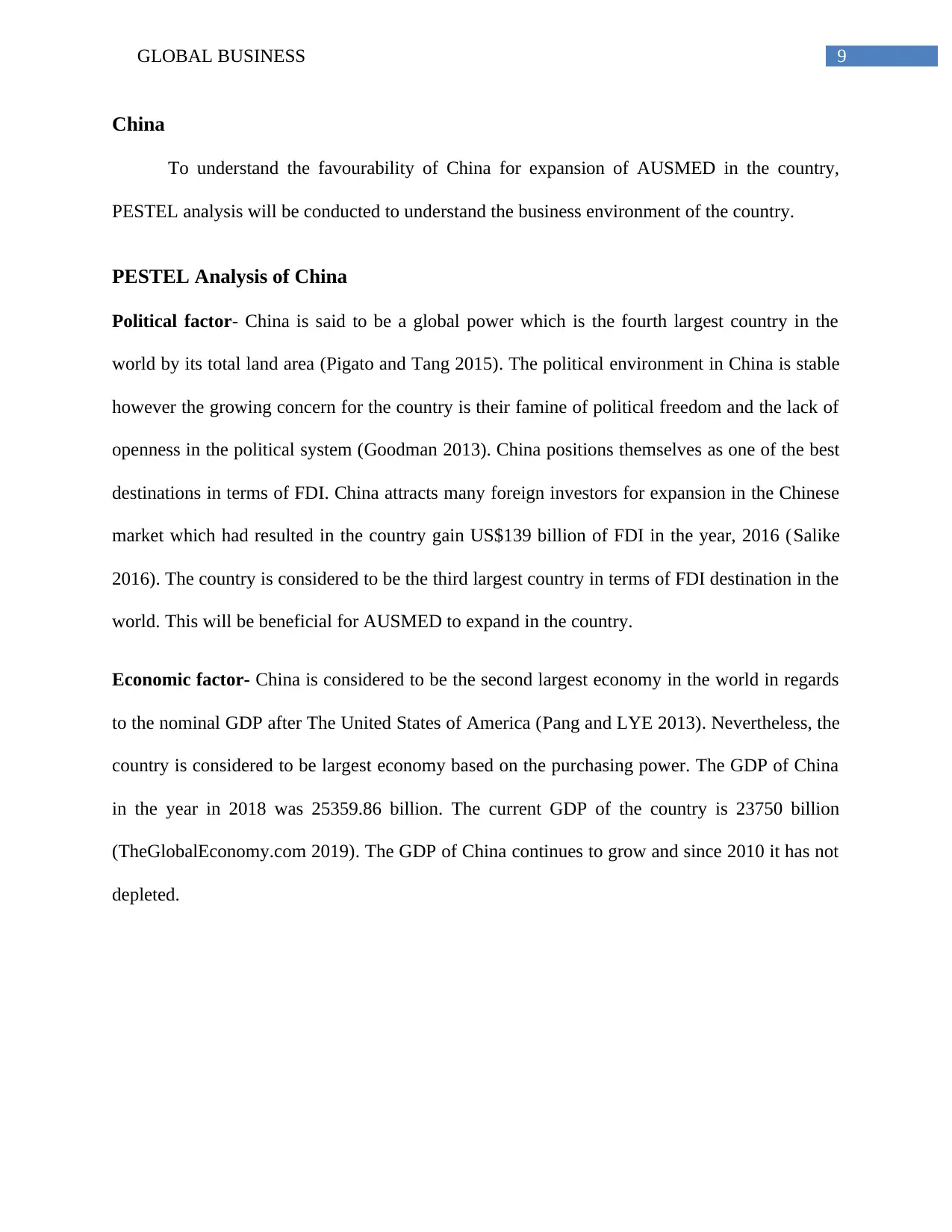
9GLOBAL BUSINESS
China
To understand the favourability of China for expansion of AUSMED in the country,
PESTEL analysis will be conducted to understand the business environment of the country.
PESTEL Analysis of China
Political factor- China is said to be a global power which is the fourth largest country in the
world by its total land area (Pigato and Tang 2015). The political environment in China is stable
however the growing concern for the country is their famine of political freedom and the lack of
openness in the political system (Goodman 2013). China positions themselves as one of the best
destinations in terms of FDI. China attracts many foreign investors for expansion in the Chinese
market which had resulted in the country gain US$139 billion of FDI in the year, 2016 (Salike
2016). The country is considered to be the third largest country in terms of FDI destination in the
world. This will be beneficial for AUSMED to expand in the country.
Economic factor- China is considered to be the second largest economy in the world in regards
to the nominal GDP after The United States of America (Pang and LYE 2013). Nevertheless, the
country is considered to be largest economy based on the purchasing power. The GDP of China
in the year in 2018 was 25359.86 billion. The current GDP of the country is 23750 billion
(TheGlobalEconomy.com 2019). The GDP of China continues to grow and since 2010 it has not
depleted.
China
To understand the favourability of China for expansion of AUSMED in the country,
PESTEL analysis will be conducted to understand the business environment of the country.
PESTEL Analysis of China
Political factor- China is said to be a global power which is the fourth largest country in the
world by its total land area (Pigato and Tang 2015). The political environment in China is stable
however the growing concern for the country is their famine of political freedom and the lack of
openness in the political system (Goodman 2013). China positions themselves as one of the best
destinations in terms of FDI. China attracts many foreign investors for expansion in the Chinese
market which had resulted in the country gain US$139 billion of FDI in the year, 2016 (Salike
2016). The country is considered to be the third largest country in terms of FDI destination in the
world. This will be beneficial for AUSMED to expand in the country.
Economic factor- China is considered to be the second largest economy in the world in regards
to the nominal GDP after The United States of America (Pang and LYE 2013). Nevertheless, the
country is considered to be largest economy based on the purchasing power. The GDP of China
in the year in 2018 was 25359.86 billion. The current GDP of the country is 23750 billion
(TheGlobalEconomy.com 2019). The GDP of China continues to grow and since 2010 it has not
depleted.
Secure Best Marks with AI Grader
Need help grading? Try our AI Grader for instant feedback on your assignments.
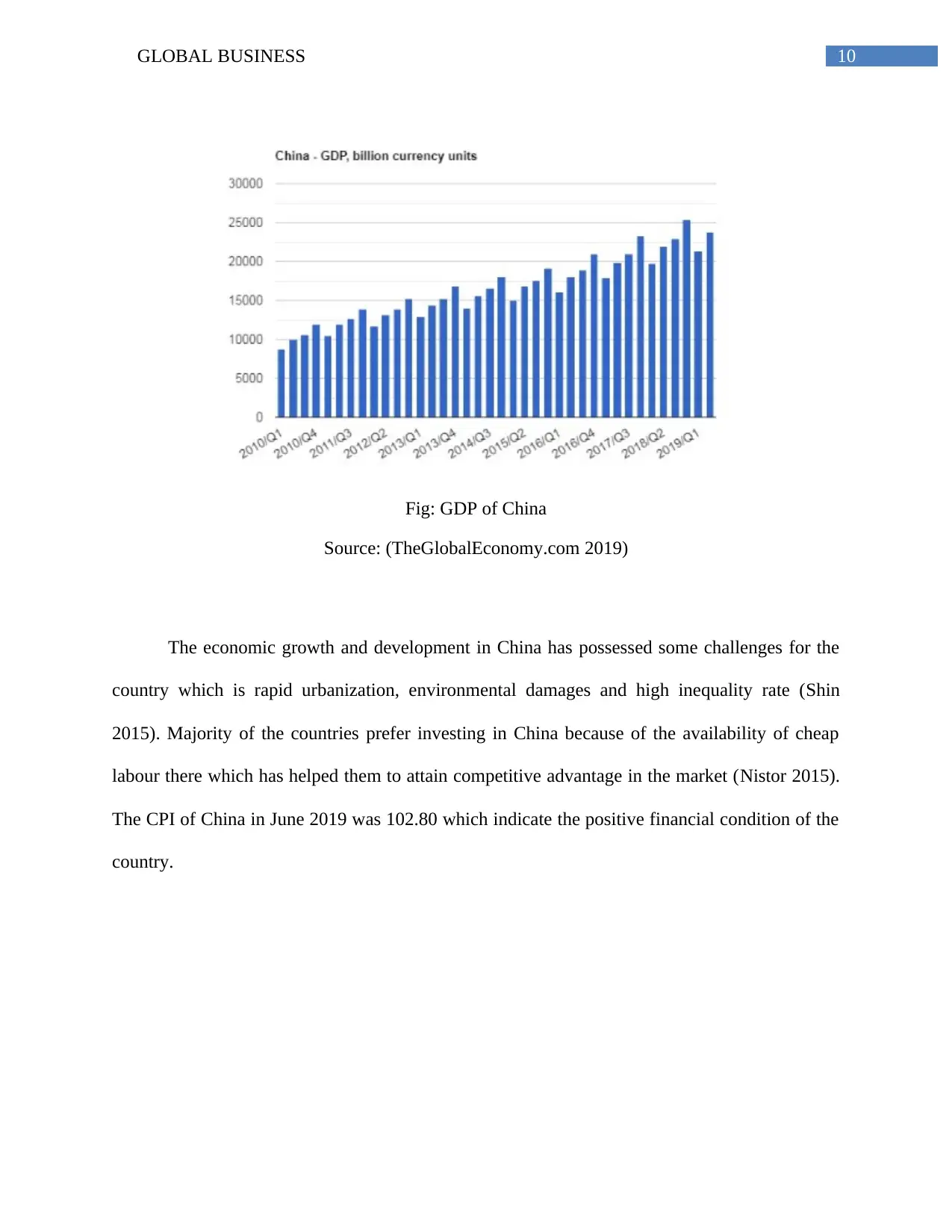
10GLOBAL BUSINESS
Fig: GDP of China
Source: (TheGlobalEconomy.com 2019)
The economic growth and development in China has possessed some challenges for the
country which is rapid urbanization, environmental damages and high inequality rate (Shin
2015). Majority of the countries prefer investing in China because of the availability of cheap
labour there which has helped them to attain competitive advantage in the market (Nistor 2015).
The CPI of China in June 2019 was 102.80 which indicate the positive financial condition of the
country.
Fig: GDP of China
Source: (TheGlobalEconomy.com 2019)
The economic growth and development in China has possessed some challenges for the
country which is rapid urbanization, environmental damages and high inequality rate (Shin
2015). Majority of the countries prefer investing in China because of the availability of cheap
labour there which has helped them to attain competitive advantage in the market (Nistor 2015).
The CPI of China in June 2019 was 102.80 which indicate the positive financial condition of the
country.
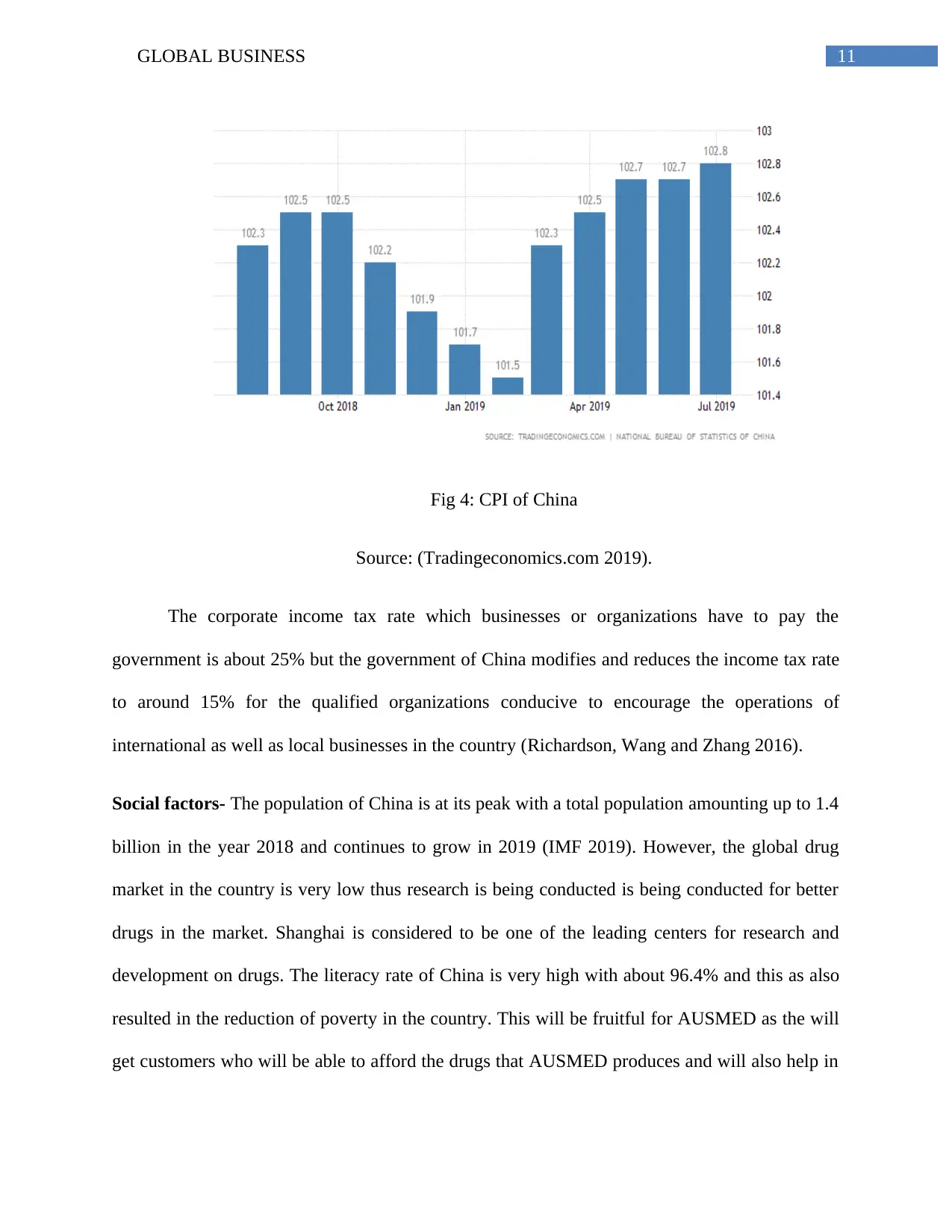
11GLOBAL BUSINESS
Fig 4: CPI of China
Source: (Tradingeconomics.com 2019).
The corporate income tax rate which businesses or organizations have to pay the
government is about 25% but the government of China modifies and reduces the income tax rate
to around 15% for the qualified organizations conducive to encourage the operations of
international as well as local businesses in the country (Richardson, Wang and Zhang 2016).
Social factors- The population of China is at its peak with a total population amounting up to 1.4
billion in the year 2018 and continues to grow in 2019 (IMF 2019). However, the global drug
market in the country is very low thus research is being conducted is being conducted for better
drugs in the market. Shanghai is considered to be one of the leading centers for research and
development on drugs. The literacy rate of China is very high with about 96.4% and this as also
resulted in the reduction of poverty in the country. This will be fruitful for AUSMED as the will
get customers who will be able to afford the drugs that AUSMED produces and will also help in
Fig 4: CPI of China
Source: (Tradingeconomics.com 2019).
The corporate income tax rate which businesses or organizations have to pay the
government is about 25% but the government of China modifies and reduces the income tax rate
to around 15% for the qualified organizations conducive to encourage the operations of
international as well as local businesses in the country (Richardson, Wang and Zhang 2016).
Social factors- The population of China is at its peak with a total population amounting up to 1.4
billion in the year 2018 and continues to grow in 2019 (IMF 2019). However, the global drug
market in the country is very low thus research is being conducted is being conducted for better
drugs in the market. Shanghai is considered to be one of the leading centers for research and
development on drugs. The literacy rate of China is very high with about 96.4% and this as also
resulted in the reduction of poverty in the country. This will be fruitful for AUSMED as the will
get customers who will be able to afford the drugs that AUSMED produces and will also help in
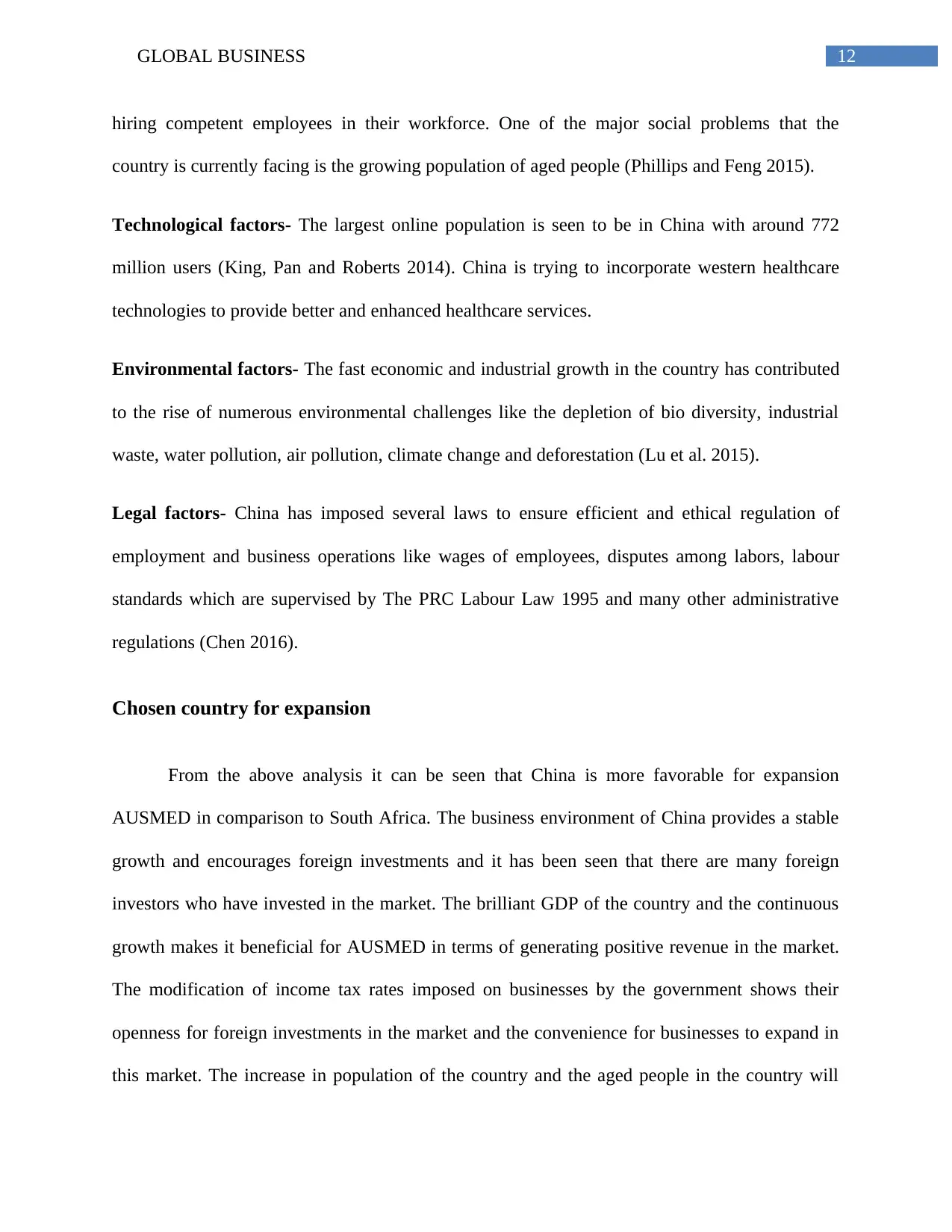
12GLOBAL BUSINESS
hiring competent employees in their workforce. One of the major social problems that the
country is currently facing is the growing population of aged people (Phillips and Feng 2015).
Technological factors- The largest online population is seen to be in China with around 772
million users (King, Pan and Roberts 2014). China is trying to incorporate western healthcare
technologies to provide better and enhanced healthcare services.
Environmental factors- The fast economic and industrial growth in the country has contributed
to the rise of numerous environmental challenges like the depletion of bio diversity, industrial
waste, water pollution, air pollution, climate change and deforestation (Lu et al. 2015).
Legal factors- China has imposed several laws to ensure efficient and ethical regulation of
employment and business operations like wages of employees, disputes among labors, labour
standards which are supervised by The PRC Labour Law 1995 and many other administrative
regulations (Chen 2016).
Chosen country for expansion
From the above analysis it can be seen that China is more favorable for expansion
AUSMED in comparison to South Africa. The business environment of China provides a stable
growth and encourages foreign investments and it has been seen that there are many foreign
investors who have invested in the market. The brilliant GDP of the country and the continuous
growth makes it beneficial for AUSMED in terms of generating positive revenue in the market.
The modification of income tax rates imposed on businesses by the government shows their
openness for foreign investments in the market and the convenience for businesses to expand in
this market. The increase in population of the country and the aged people in the country will
hiring competent employees in their workforce. One of the major social problems that the
country is currently facing is the growing population of aged people (Phillips and Feng 2015).
Technological factors- The largest online population is seen to be in China with around 772
million users (King, Pan and Roberts 2014). China is trying to incorporate western healthcare
technologies to provide better and enhanced healthcare services.
Environmental factors- The fast economic and industrial growth in the country has contributed
to the rise of numerous environmental challenges like the depletion of bio diversity, industrial
waste, water pollution, air pollution, climate change and deforestation (Lu et al. 2015).
Legal factors- China has imposed several laws to ensure efficient and ethical regulation of
employment and business operations like wages of employees, disputes among labors, labour
standards which are supervised by The PRC Labour Law 1995 and many other administrative
regulations (Chen 2016).
Chosen country for expansion
From the above analysis it can be seen that China is more favorable for expansion
AUSMED in comparison to South Africa. The business environment of China provides a stable
growth and encourages foreign investments and it has been seen that there are many foreign
investors who have invested in the market. The brilliant GDP of the country and the continuous
growth makes it beneficial for AUSMED in terms of generating positive revenue in the market.
The modification of income tax rates imposed on businesses by the government shows their
openness for foreign investments in the market and the convenience for businesses to expand in
this market. The increase in population of the country and the aged people in the country will
Paraphrase This Document
Need a fresh take? Get an instant paraphrase of this document with our AI Paraphraser
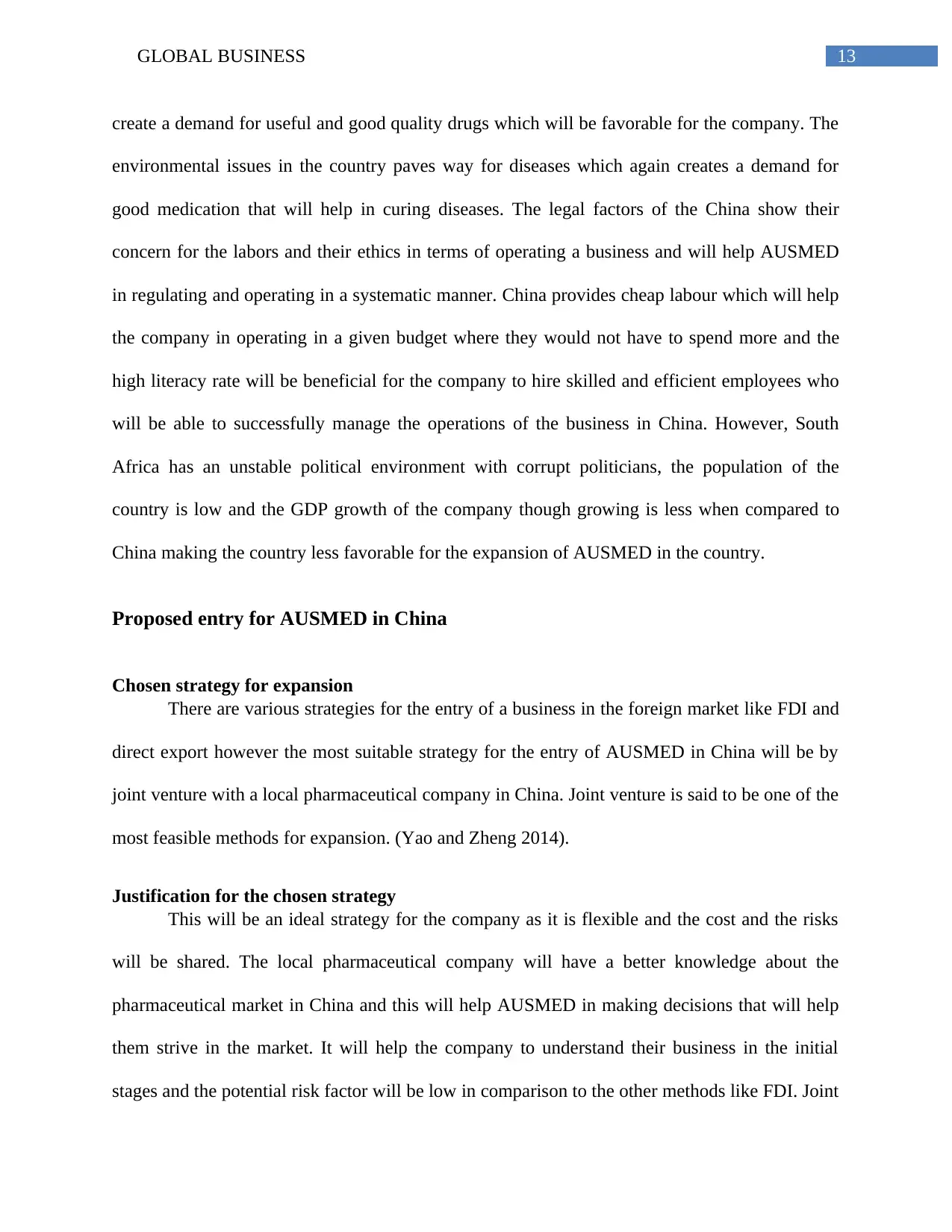
13GLOBAL BUSINESS
create a demand for useful and good quality drugs which will be favorable for the company. The
environmental issues in the country paves way for diseases which again creates a demand for
good medication that will help in curing diseases. The legal factors of the China show their
concern for the labors and their ethics in terms of operating a business and will help AUSMED
in regulating and operating in a systematic manner. China provides cheap labour which will help
the company in operating in a given budget where they would not have to spend more and the
high literacy rate will be beneficial for the company to hire skilled and efficient employees who
will be able to successfully manage the operations of the business in China. However, South
Africa has an unstable political environment with corrupt politicians, the population of the
country is low and the GDP growth of the company though growing is less when compared to
China making the country less favorable for the expansion of AUSMED in the country.
Proposed entry for AUSMED in China
Chosen strategy for expansion
There are various strategies for the entry of a business in the foreign market like FDI and
direct export however the most suitable strategy for the entry of AUSMED in China will be by
joint venture with a local pharmaceutical company in China. Joint venture is said to be one of the
most feasible methods for expansion. (Yao and Zheng 2014).
Justification for the chosen strategy
This will be an ideal strategy for the company as it is flexible and the cost and the risks
will be shared. The local pharmaceutical company will have a better knowledge about the
pharmaceutical market in China and this will help AUSMED in making decisions that will help
them strive in the market. It will help the company to understand their business in the initial
stages and the potential risk factor will be low in comparison to the other methods like FDI. Joint
create a demand for useful and good quality drugs which will be favorable for the company. The
environmental issues in the country paves way for diseases which again creates a demand for
good medication that will help in curing diseases. The legal factors of the China show their
concern for the labors and their ethics in terms of operating a business and will help AUSMED
in regulating and operating in a systematic manner. China provides cheap labour which will help
the company in operating in a given budget where they would not have to spend more and the
high literacy rate will be beneficial for the company to hire skilled and efficient employees who
will be able to successfully manage the operations of the business in China. However, South
Africa has an unstable political environment with corrupt politicians, the population of the
country is low and the GDP growth of the company though growing is less when compared to
China making the country less favorable for the expansion of AUSMED in the country.
Proposed entry for AUSMED in China
Chosen strategy for expansion
There are various strategies for the entry of a business in the foreign market like FDI and
direct export however the most suitable strategy for the entry of AUSMED in China will be by
joint venture with a local pharmaceutical company in China. Joint venture is said to be one of the
most feasible methods for expansion. (Yao and Zheng 2014).
Justification for the chosen strategy
This will be an ideal strategy for the company as it is flexible and the cost and the risks
will be shared. The local pharmaceutical company will have a better knowledge about the
pharmaceutical market in China and this will help AUSMED in making decisions that will help
them strive in the market. It will help the company to understand their business in the initial
stages and the potential risk factor will be low in comparison to the other methods like FDI. Joint
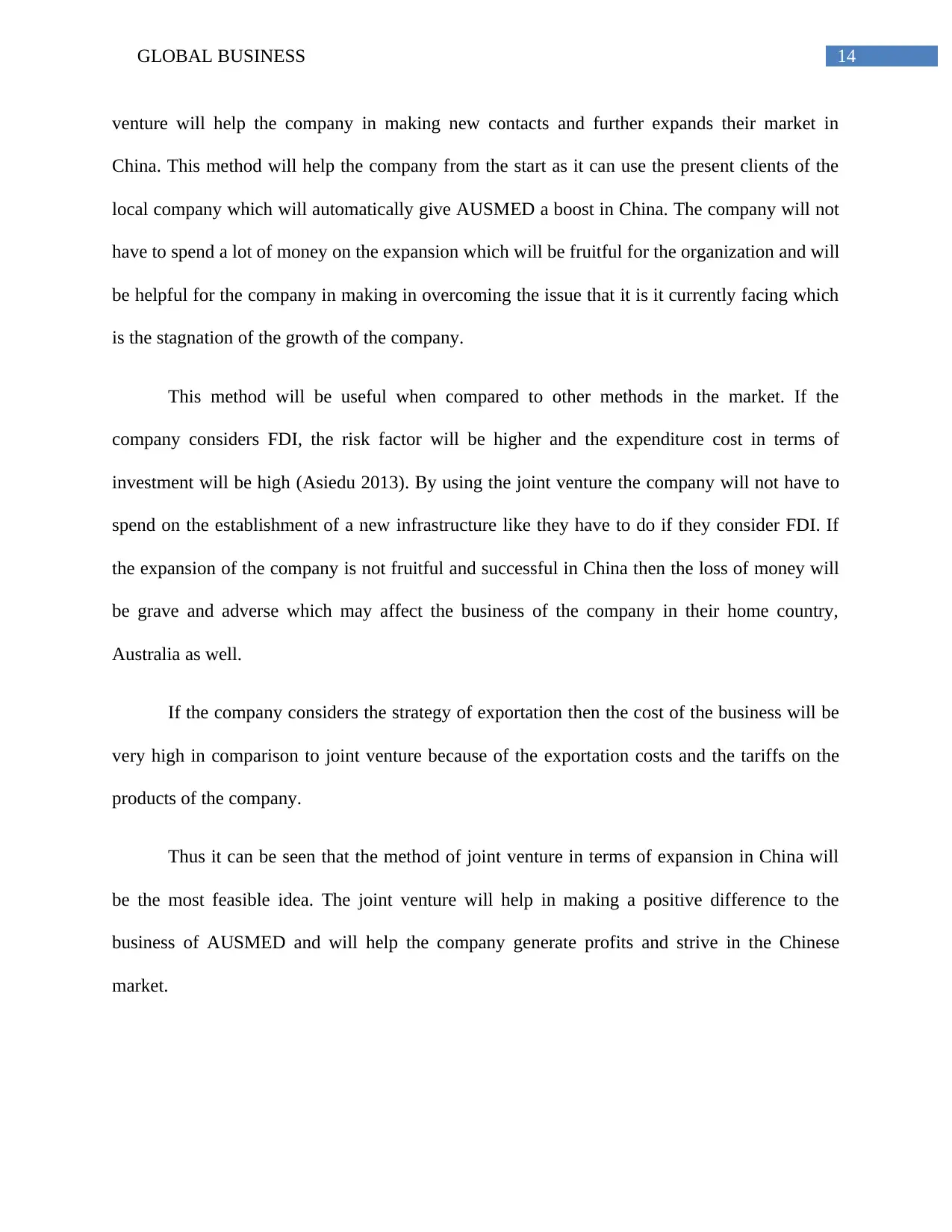
14GLOBAL BUSINESS
venture will help the company in making new contacts and further expands their market in
China. This method will help the company from the start as it can use the present clients of the
local company which will automatically give AUSMED a boost in China. The company will not
have to spend a lot of money on the expansion which will be fruitful for the organization and will
be helpful for the company in making in overcoming the issue that it is it currently facing which
is the stagnation of the growth of the company.
This method will be useful when compared to other methods in the market. If the
company considers FDI, the risk factor will be higher and the expenditure cost in terms of
investment will be high (Asiedu 2013). By using the joint venture the company will not have to
spend on the establishment of a new infrastructure like they have to do if they consider FDI. If
the expansion of the company is not fruitful and successful in China then the loss of money will
be grave and adverse which may affect the business of the company in their home country,
Australia as well.
If the company considers the strategy of exportation then the cost of the business will be
very high in comparison to joint venture because of the exportation costs and the tariffs on the
products of the company.
Thus it can be seen that the method of joint venture in terms of expansion in China will
be the most feasible idea. The joint venture will help in making a positive difference to the
business of AUSMED and will help the company generate profits and strive in the Chinese
market.
venture will help the company in making new contacts and further expands their market in
China. This method will help the company from the start as it can use the present clients of the
local company which will automatically give AUSMED a boost in China. The company will not
have to spend a lot of money on the expansion which will be fruitful for the organization and will
be helpful for the company in making in overcoming the issue that it is it currently facing which
is the stagnation of the growth of the company.
This method will be useful when compared to other methods in the market. If the
company considers FDI, the risk factor will be higher and the expenditure cost in terms of
investment will be high (Asiedu 2013). By using the joint venture the company will not have to
spend on the establishment of a new infrastructure like they have to do if they consider FDI. If
the expansion of the company is not fruitful and successful in China then the loss of money will
be grave and adverse which may affect the business of the company in their home country,
Australia as well.
If the company considers the strategy of exportation then the cost of the business will be
very high in comparison to joint venture because of the exportation costs and the tariffs on the
products of the company.
Thus it can be seen that the method of joint venture in terms of expansion in China will
be the most feasible idea. The joint venture will help in making a positive difference to the
business of AUSMED and will help the company generate profits and strive in the Chinese
market.
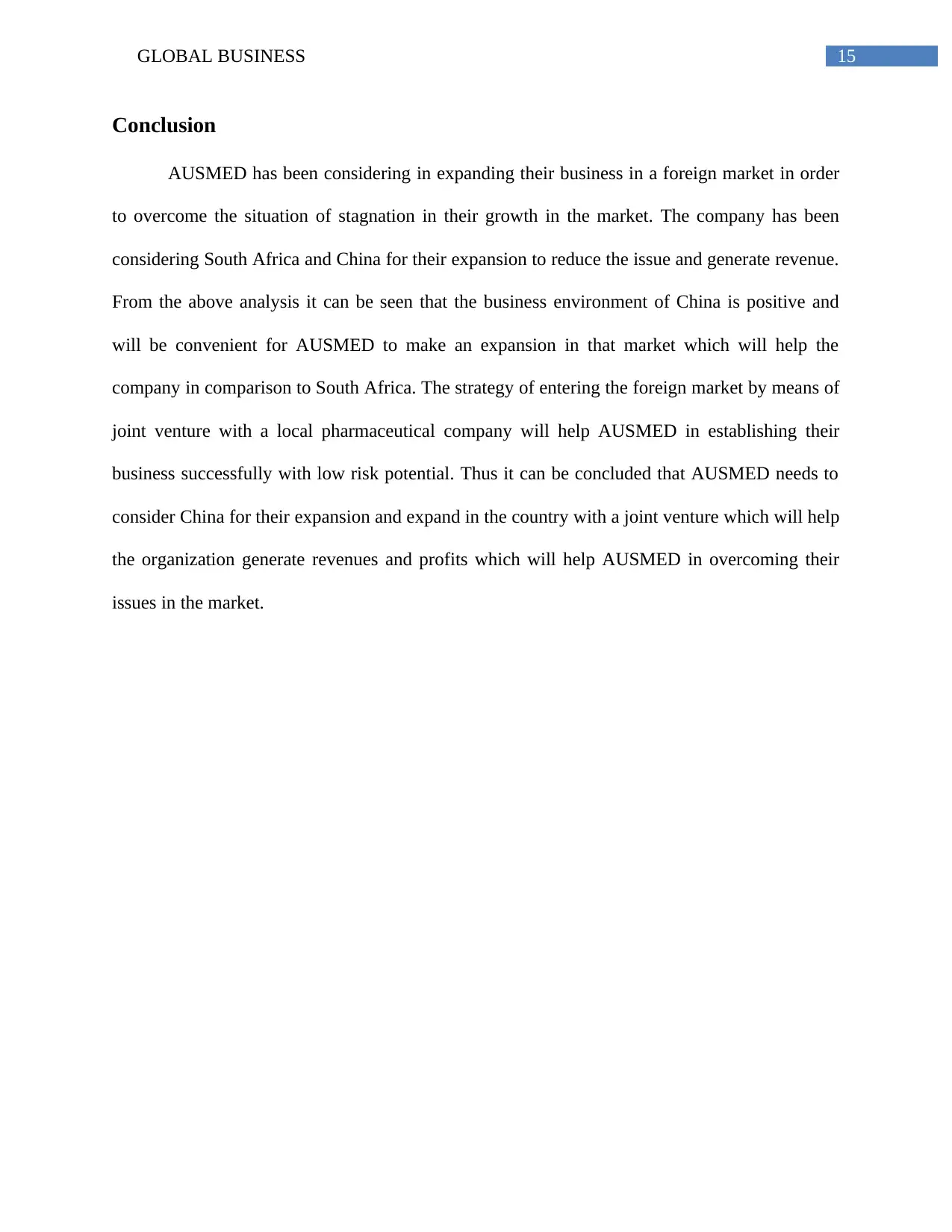
15GLOBAL BUSINESS
Conclusion
AUSMED has been considering in expanding their business in a foreign market in order
to overcome the situation of stagnation in their growth in the market. The company has been
considering South Africa and China for their expansion to reduce the issue and generate revenue.
From the above analysis it can be seen that the business environment of China is positive and
will be convenient for AUSMED to make an expansion in that market which will help the
company in comparison to South Africa. The strategy of entering the foreign market by means of
joint venture with a local pharmaceutical company will help AUSMED in establishing their
business successfully with low risk potential. Thus it can be concluded that AUSMED needs to
consider China for their expansion and expand in the country with a joint venture which will help
the organization generate revenues and profits which will help AUSMED in overcoming their
issues in the market.
Conclusion
AUSMED has been considering in expanding their business in a foreign market in order
to overcome the situation of stagnation in their growth in the market. The company has been
considering South Africa and China for their expansion to reduce the issue and generate revenue.
From the above analysis it can be seen that the business environment of China is positive and
will be convenient for AUSMED to make an expansion in that market which will help the
company in comparison to South Africa. The strategy of entering the foreign market by means of
joint venture with a local pharmaceutical company will help AUSMED in establishing their
business successfully with low risk potential. Thus it can be concluded that AUSMED needs to
consider China for their expansion and expand in the country with a joint venture which will help
the organization generate revenues and profits which will help AUSMED in overcoming their
issues in the market.
Secure Best Marks with AI Grader
Need help grading? Try our AI Grader for instant feedback on your assignments.
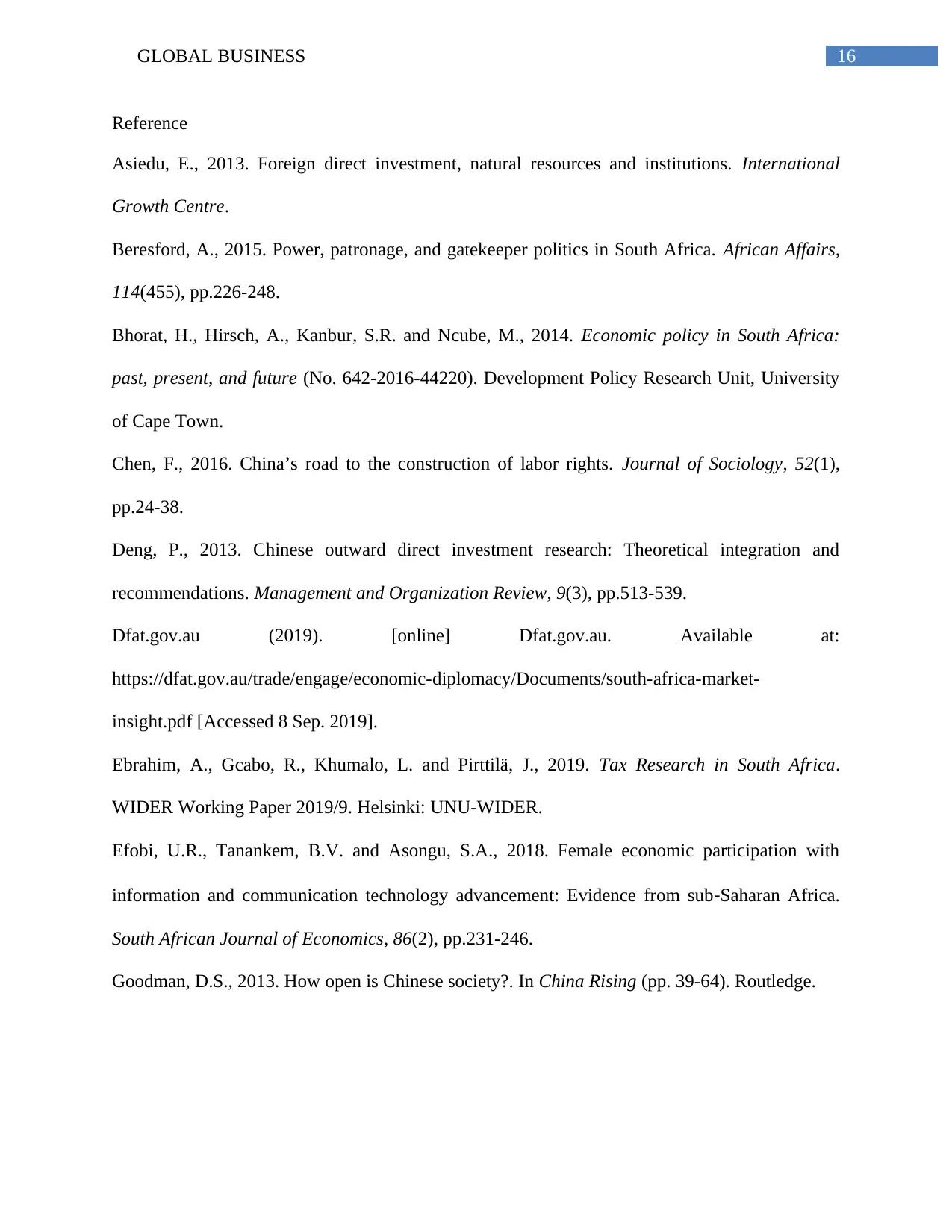
16GLOBAL BUSINESS
Reference
Asiedu, E., 2013. Foreign direct investment, natural resources and institutions. International
Growth Centre.
Beresford, A., 2015. Power, patronage, and gatekeeper politics in South Africa. African Affairs,
114(455), pp.226-248.
Bhorat, H., Hirsch, A., Kanbur, S.R. and Ncube, M., 2014. Economic policy in South Africa:
past, present, and future (No. 642-2016-44220). Development Policy Research Unit, University
of Cape Town.
Chen, F., 2016. China’s road to the construction of labor rights. Journal of Sociology, 52(1),
pp.24-38.
Deng, P., 2013. Chinese outward direct investment research: Theoretical integration and
recommendations. Management and Organization Review, 9(3), pp.513-539.
Dfat.gov.au (2019). [online] Dfat.gov.au. Available at:
https://dfat.gov.au/trade/engage/economic-diplomacy/Documents/south-africa-market-
insight.pdf [Accessed 8 Sep. 2019].
Ebrahim, A., Gcabo, R., Khumalo, L. and Pirttilä, J., 2019. Tax Research in South Africa.
WIDER Working Paper 2019/9. Helsinki: UNU-WIDER.
Efobi, U.R., Tanankem, B.V. and Asongu, S.A., 2018. Female economic participation with
information and communication technology advancement: Evidence from sub‐Saharan Africa.
South African Journal of Economics, 86(2), pp.231-246.
Goodman, D.S., 2013. How open is Chinese society?. In China Rising (pp. 39-64). Routledge.
Reference
Asiedu, E., 2013. Foreign direct investment, natural resources and institutions. International
Growth Centre.
Beresford, A., 2015. Power, patronage, and gatekeeper politics in South Africa. African Affairs,
114(455), pp.226-248.
Bhorat, H., Hirsch, A., Kanbur, S.R. and Ncube, M., 2014. Economic policy in South Africa:
past, present, and future (No. 642-2016-44220). Development Policy Research Unit, University
of Cape Town.
Chen, F., 2016. China’s road to the construction of labor rights. Journal of Sociology, 52(1),
pp.24-38.
Deng, P., 2013. Chinese outward direct investment research: Theoretical integration and
recommendations. Management and Organization Review, 9(3), pp.513-539.
Dfat.gov.au (2019). [online] Dfat.gov.au. Available at:
https://dfat.gov.au/trade/engage/economic-diplomacy/Documents/south-africa-market-
insight.pdf [Accessed 8 Sep. 2019].
Ebrahim, A., Gcabo, R., Khumalo, L. and Pirttilä, J., 2019. Tax Research in South Africa.
WIDER Working Paper 2019/9. Helsinki: UNU-WIDER.
Efobi, U.R., Tanankem, B.V. and Asongu, S.A., 2018. Female economic participation with
information and communication technology advancement: Evidence from sub‐Saharan Africa.
South African Journal of Economics, 86(2), pp.231-246.
Goodman, D.S., 2013. How open is Chinese society?. In China Rising (pp. 39-64). Routledge.
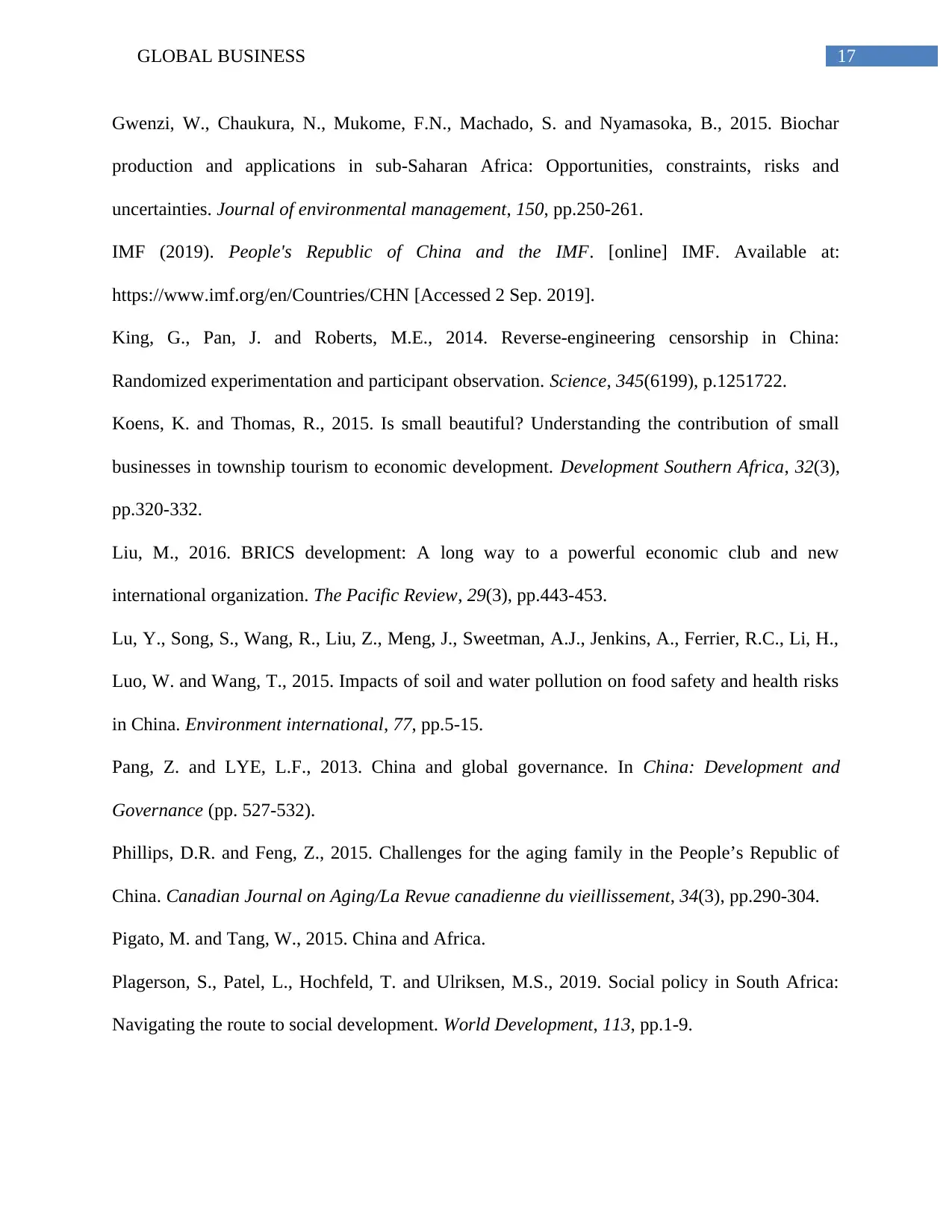
17GLOBAL BUSINESS
Gwenzi, W., Chaukura, N., Mukome, F.N., Machado, S. and Nyamasoka, B., 2015. Biochar
production and applications in sub-Saharan Africa: Opportunities, constraints, risks and
uncertainties. Journal of environmental management, 150, pp.250-261.
IMF (2019). People's Republic of China and the IMF. [online] IMF. Available at:
https://www.imf.org/en/Countries/CHN [Accessed 2 Sep. 2019].
King, G., Pan, J. and Roberts, M.E., 2014. Reverse-engineering censorship in China:
Randomized experimentation and participant observation. Science, 345(6199), p.1251722.
Koens, K. and Thomas, R., 2015. Is small beautiful? Understanding the contribution of small
businesses in township tourism to economic development. Development Southern Africa, 32(3),
pp.320-332.
Liu, M., 2016. BRICS development: A long way to a powerful economic club and new
international organization. The Pacific Review, 29(3), pp.443-453.
Lu, Y., Song, S., Wang, R., Liu, Z., Meng, J., Sweetman, A.J., Jenkins, A., Ferrier, R.C., Li, H.,
Luo, W. and Wang, T., 2015. Impacts of soil and water pollution on food safety and health risks
in China. Environment international, 77, pp.5-15.
Pang, Z. and LYE, L.F., 2013. China and global governance. In China: Development and
Governance (pp. 527-532).
Phillips, D.R. and Feng, Z., 2015. Challenges for the aging family in the People’s Republic of
China. Canadian Journal on Aging/La Revue canadienne du vieillissement, 34(3), pp.290-304.
Pigato, M. and Tang, W., 2015. China and Africa.
Plagerson, S., Patel, L., Hochfeld, T. and Ulriksen, M.S., 2019. Social policy in South Africa:
Navigating the route to social development. World Development, 113, pp.1-9.
Gwenzi, W., Chaukura, N., Mukome, F.N., Machado, S. and Nyamasoka, B., 2015. Biochar
production and applications in sub-Saharan Africa: Opportunities, constraints, risks and
uncertainties. Journal of environmental management, 150, pp.250-261.
IMF (2019). People's Republic of China and the IMF. [online] IMF. Available at:
https://www.imf.org/en/Countries/CHN [Accessed 2 Sep. 2019].
King, G., Pan, J. and Roberts, M.E., 2014. Reverse-engineering censorship in China:
Randomized experimentation and participant observation. Science, 345(6199), p.1251722.
Koens, K. and Thomas, R., 2015. Is small beautiful? Understanding the contribution of small
businesses in township tourism to economic development. Development Southern Africa, 32(3),
pp.320-332.
Liu, M., 2016. BRICS development: A long way to a powerful economic club and new
international organization. The Pacific Review, 29(3), pp.443-453.
Lu, Y., Song, S., Wang, R., Liu, Z., Meng, J., Sweetman, A.J., Jenkins, A., Ferrier, R.C., Li, H.,
Luo, W. and Wang, T., 2015. Impacts of soil and water pollution on food safety and health risks
in China. Environment international, 77, pp.5-15.
Pang, Z. and LYE, L.F., 2013. China and global governance. In China: Development and
Governance (pp. 527-532).
Phillips, D.R. and Feng, Z., 2015. Challenges for the aging family in the People’s Republic of
China. Canadian Journal on Aging/La Revue canadienne du vieillissement, 34(3), pp.290-304.
Pigato, M. and Tang, W., 2015. China and Africa.
Plagerson, S., Patel, L., Hochfeld, T. and Ulriksen, M.S., 2019. Social policy in South Africa:
Navigating the route to social development. World Development, 113, pp.1-9.
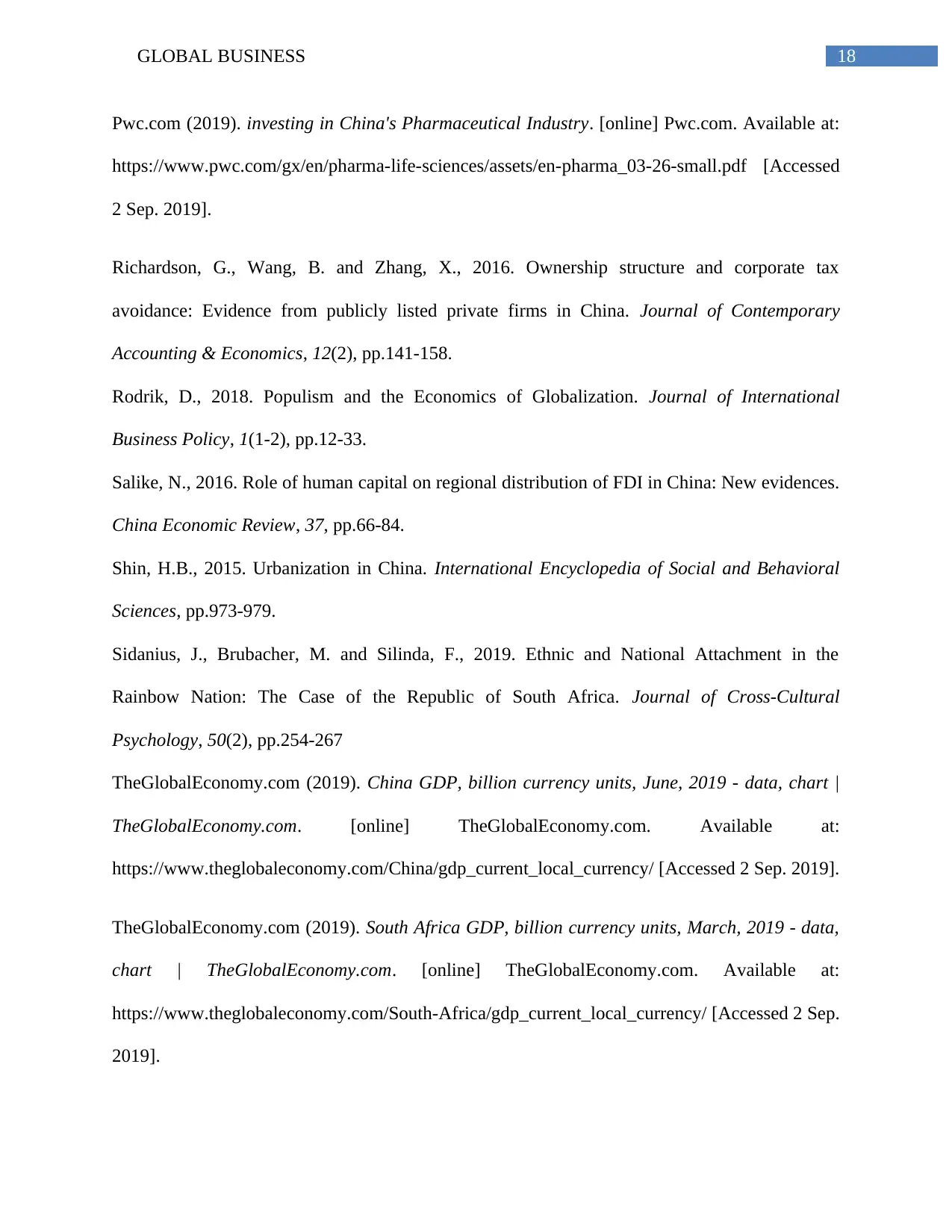
18GLOBAL BUSINESS
Pwc.com (2019). investing in China's Pharmaceutical Industry. [online] Pwc.com. Available at:
https://www.pwc.com/gx/en/pharma-life-sciences/assets/en-pharma_03-26-small.pdf [Accessed
2 Sep. 2019].
Richardson, G., Wang, B. and Zhang, X., 2016. Ownership structure and corporate tax
avoidance: Evidence from publicly listed private firms in China. Journal of Contemporary
Accounting & Economics, 12(2), pp.141-158.
Rodrik, D., 2018. Populism and the Economics of Globalization. Journal of International
Business Policy, 1(1-2), pp.12-33.
Salike, N., 2016. Role of human capital on regional distribution of FDI in China: New evidences.
China Economic Review, 37, pp.66-84.
Shin, H.B., 2015. Urbanization in China. International Encyclopedia of Social and Behavioral
Sciences, pp.973-979.
Sidanius, J., Brubacher, M. and Silinda, F., 2019. Ethnic and National Attachment in the
Rainbow Nation: The Case of the Republic of South Africa. Journal of Cross-Cultural
Psychology, 50(2), pp.254-267
TheGlobalEconomy.com (2019). China GDP, billion currency units, June, 2019 - data, chart |
TheGlobalEconomy.com. [online] TheGlobalEconomy.com. Available at:
https://www.theglobaleconomy.com/China/gdp_current_local_currency/ [Accessed 2 Sep. 2019].
TheGlobalEconomy.com (2019). South Africa GDP, billion currency units, March, 2019 - data,
chart | TheGlobalEconomy.com. [online] TheGlobalEconomy.com. Available at:
https://www.theglobaleconomy.com/South-Africa/gdp_current_local_currency/ [Accessed 2 Sep.
2019].
Pwc.com (2019). investing in China's Pharmaceutical Industry. [online] Pwc.com. Available at:
https://www.pwc.com/gx/en/pharma-life-sciences/assets/en-pharma_03-26-small.pdf [Accessed
2 Sep. 2019].
Richardson, G., Wang, B. and Zhang, X., 2016. Ownership structure and corporate tax
avoidance: Evidence from publicly listed private firms in China. Journal of Contemporary
Accounting & Economics, 12(2), pp.141-158.
Rodrik, D., 2018. Populism and the Economics of Globalization. Journal of International
Business Policy, 1(1-2), pp.12-33.
Salike, N., 2016. Role of human capital on regional distribution of FDI in China: New evidences.
China Economic Review, 37, pp.66-84.
Shin, H.B., 2015. Urbanization in China. International Encyclopedia of Social and Behavioral
Sciences, pp.973-979.
Sidanius, J., Brubacher, M. and Silinda, F., 2019. Ethnic and National Attachment in the
Rainbow Nation: The Case of the Republic of South Africa. Journal of Cross-Cultural
Psychology, 50(2), pp.254-267
TheGlobalEconomy.com (2019). China GDP, billion currency units, June, 2019 - data, chart |
TheGlobalEconomy.com. [online] TheGlobalEconomy.com. Available at:
https://www.theglobaleconomy.com/China/gdp_current_local_currency/ [Accessed 2 Sep. 2019].
TheGlobalEconomy.com (2019). South Africa GDP, billion currency units, March, 2019 - data,
chart | TheGlobalEconomy.com. [online] TheGlobalEconomy.com. Available at:
https://www.theglobaleconomy.com/South-Africa/gdp_current_local_currency/ [Accessed 2 Sep.
2019].
Paraphrase This Document
Need a fresh take? Get an instant paraphrase of this document with our AI Paraphraser
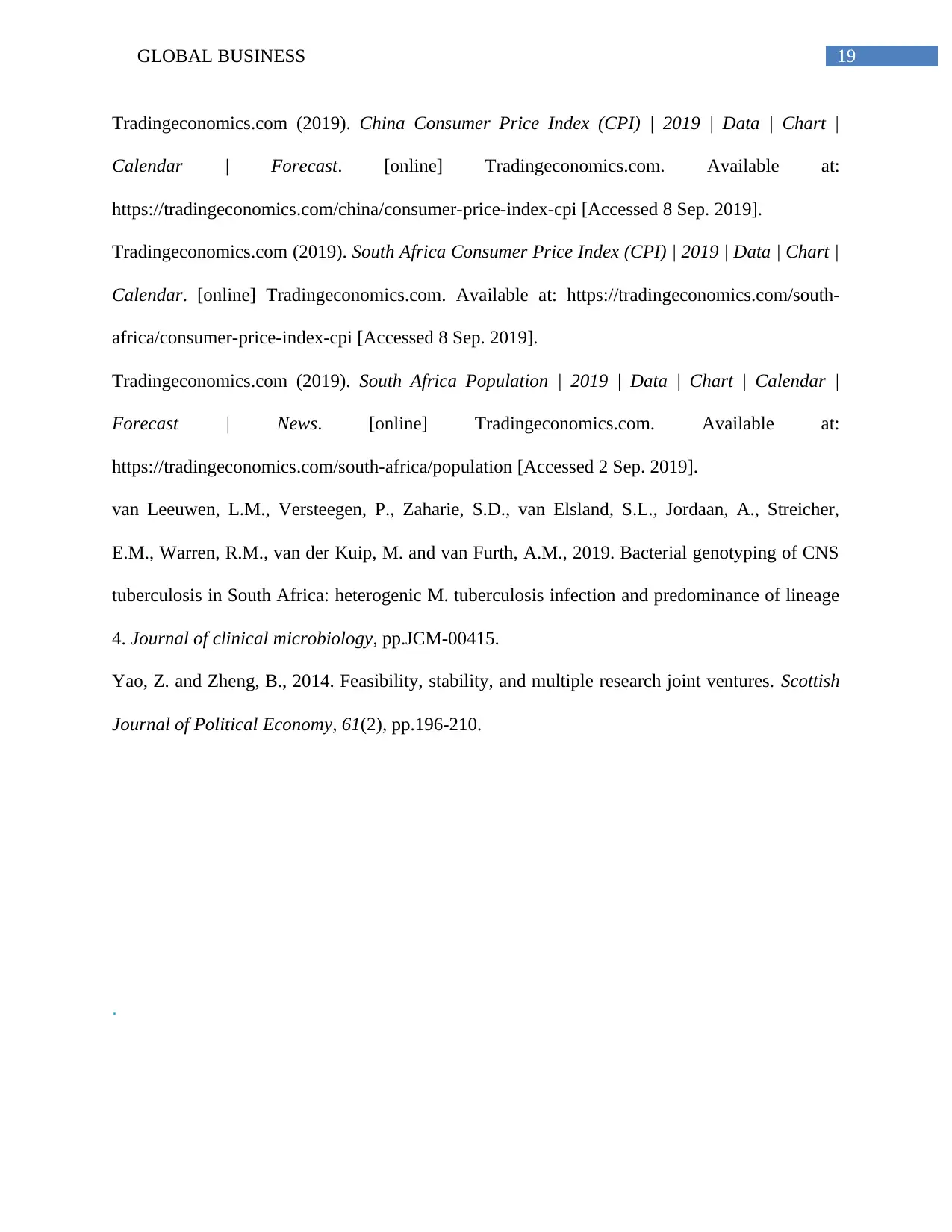
19GLOBAL BUSINESS
Tradingeconomics.com (2019). China Consumer Price Index (CPI) | 2019 | Data | Chart |
Calendar | Forecast. [online] Tradingeconomics.com. Available at:
https://tradingeconomics.com/china/consumer-price-index-cpi [Accessed 8 Sep. 2019].
Tradingeconomics.com (2019). South Africa Consumer Price Index (CPI) | 2019 | Data | Chart |
Calendar. [online] Tradingeconomics.com. Available at: https://tradingeconomics.com/south-
africa/consumer-price-index-cpi [Accessed 8 Sep. 2019].
Tradingeconomics.com (2019). South Africa Population | 2019 | Data | Chart | Calendar |
Forecast | News. [online] Tradingeconomics.com. Available at:
https://tradingeconomics.com/south-africa/population [Accessed 2 Sep. 2019].
van Leeuwen, L.M., Versteegen, P., Zaharie, S.D., van Elsland, S.L., Jordaan, A., Streicher,
E.M., Warren, R.M., van der Kuip, M. and van Furth, A.M., 2019. Bacterial genotyping of CNS
tuberculosis in South Africa: heterogenic M. tuberculosis infection and predominance of lineage
4. Journal of clinical microbiology, pp.JCM-00415.
Yao, Z. and Zheng, B., 2014. Feasibility, stability, and multiple research joint ventures. Scottish
Journal of Political Economy, 61(2), pp.196-210.
.
Tradingeconomics.com (2019). China Consumer Price Index (CPI) | 2019 | Data | Chart |
Calendar | Forecast. [online] Tradingeconomics.com. Available at:
https://tradingeconomics.com/china/consumer-price-index-cpi [Accessed 8 Sep. 2019].
Tradingeconomics.com (2019). South Africa Consumer Price Index (CPI) | 2019 | Data | Chart |
Calendar. [online] Tradingeconomics.com. Available at: https://tradingeconomics.com/south-
africa/consumer-price-index-cpi [Accessed 8 Sep. 2019].
Tradingeconomics.com (2019). South Africa Population | 2019 | Data | Chart | Calendar |
Forecast | News. [online] Tradingeconomics.com. Available at:
https://tradingeconomics.com/south-africa/population [Accessed 2 Sep. 2019].
van Leeuwen, L.M., Versteegen, P., Zaharie, S.D., van Elsland, S.L., Jordaan, A., Streicher,
E.M., Warren, R.M., van der Kuip, M. and van Furth, A.M., 2019. Bacterial genotyping of CNS
tuberculosis in South Africa: heterogenic M. tuberculosis infection and predominance of lineage
4. Journal of clinical microbiology, pp.JCM-00415.
Yao, Z. and Zheng, B., 2014. Feasibility, stability, and multiple research joint ventures. Scottish
Journal of Political Economy, 61(2), pp.196-210.
.
1 out of 20
Related Documents
Your All-in-One AI-Powered Toolkit for Academic Success.
+13062052269
info@desklib.com
Available 24*7 on WhatsApp / Email
![[object Object]](/_next/static/media/star-bottom.7253800d.svg)
Unlock your academic potential
© 2024 | Zucol Services PVT LTD | All rights reserved.



